HTC HERM200 Pocket PC Phone User Manual Hermes Vodafone English Manual indb
HTC Corporation Pocket PC Phone Hermes Vodafone English Manual indb
HTC >
Contents
User manual 1

Pocket
User Manual

2 |
Please Read Before Proceeding
THIS DEVICE IS NOT CHARGED WHEN YOU TAKE IT OUT OF THE
BOX.
DO NOT REMOVE THE BATTERY PACK WHEN THE DEVICE IS
CHARGING.
YOUR WARRANTY IS INVALIDATED IF YOU OPEN OR TAMPER
WITH THE DEVICE’S OUTER CASING.
PRIVACY RESTRICTIONS
Some countries require full disclosure of recorded telephone
conversations, and stipulate that you must inform the person with
whom you are speaking that the conversation is being recorded.
Always obey the relevant laws and regulations of your country when
using the recording feature of your Pocket PC Phone.
COPYRIGHT INFORMATION
Microsoft, MS-DOS, Windows, Windows NT, Windows Server,
Windows Mobile, ActiveSync, Excel, Internet Explorer, Outlook,
PowerPoint, and Word are either registered trademarks or trademarks
of Microsoft Corporation in the United States and/or other countries.
Important Health Information and Safety Precautions
When using this product, the safety precautions below must be taken to
avoid possible legal liabilities and damages.
Retain and follow all product safety and operating instructions. Observe
all warnings in the operating instructions on the product.
To reduce the risk of bodily injury, electric shock, fire, and damage to
the equipment, observe the following precautions.
ELECTRICAL SAFETY
This product is intended for use when supplied with power from
the designated battery or power supply unit. Other usage may be
dangerous and will invalidate any approval given to this product.
SAFETY PRECAUTIONS FOR PROPER GROUNDING AND
CONNECTION

| 3
CAUTION: Improper grounding when connecting the product to an
associated equipment can result in a risk of electric shock.
This product is equipped with a USB cable for connecting the product
to a desktop or notebook computer. Be sure your computer is properly
grounded (earthed) before connecting the product to the computer.
The power supply cord of a desktop or notebook computer has an
equipment-grounding conductor and a grounding plug. The plug must
be plugged into an appropriate outlet which is properly installed and
grounded in accordance with all local codes and ordinances.
SAFETY PRECAUTIONS FOR POWER SUPPLY UNIT
• Use the correct external power source
A product should be operated only from the type of power source
indicated on the electrical ratings label. If you are not sure of the
type of power source required, consult your authorized service
provider or local power company. For a product that operates
from battery power or other sources, refer to the operating
instructions that are included with the product.
• Handle battery packs carefully
This product contains a Li-ion Polymer battery. There is a risk of
fire and burns if the battery pack is handled improperly. Do not
attempt to open or service the battery pack. Do not disassemble,
crush, puncture, short external contacts or circuits, dispose of
in fire or water, or expose a battery pack to temperatures higher
than 60˚C (140˚F).
WARNING: DANGER OF EXPLOSION IF BATTERY IS
INCORRECTLY REPLACED. TO REDUCE RISK OF FIRE
OR BURNS, DO NOT DISASSEMBLE, CRUSH, PUNCTURE,
SHORT EXTERNAL CONTACTS, EXPOSE TO TEMPERATURE
ABOVE 60˚C (140˚F), OR DISPOSE OF IN FIRE OR WATER.
REPLACE ONLY WITH SPECIFIED BATTERIES. RECYCLE OR
DISPOSE OF USED BATTERIES ACCORDING TO THE LOCAL
REGULATIONS OR REFERENCE GUIDE SUPPLIED WITH
YOUR PRODUCT.

4 |
SAFETY PRECAUTIONS FOR DIRECT SUNLIGHT
Keep this product away from excessive moisture and extreme
temperatures. Do not leave the product or its battery inside a vehicle
or in places where the temperature may exceed 60°C (140°F), such
as on a car dashboard, window sill, or behind a glass that is exposed
to direct sunlight or strong ultraviolet light for extended periods of time.
This may damage the product, overheat the battery, or pose a risk to
the vehicle.
SAFETY PRECAUTIONS FOR ACOUSTIC PRESSURE
CAUTION: Using earphones or headphones and
prolonged listening at high volume levels may cause
permanent hearing loss.
NOTE: For France, mobile headphones or earphones (manufactured
by Merry, model number EMC220) for this device have been tested to
comply with the Sound Pressure Level requirement laid down in NF EN
50332-1:2000 standard as required by French Article L. 5232-1.
SAFETY IN AIRCRAFTS
Due to the possible interference caused by this product to an aircraft’s
navigation system and its communications network, using this device’s
phone function on board an airplane is against the law in most
countries. If you want to use this device when on board an aircraft,
remember to turn off your phone by switching to Flight Mode.
ENVIRONMENT RESTRICTIONS
Do not use this product in gas stations, fuel depots, chemical plants or
where blasting operations are in progress, or in potentially explosive
atmospheres such as fuelling areas, fuel storehouses, below deck on
boats, fuel or chemical transfer or storage facilities, and areas where
the air contains chemicals or particles, such as grain, dust, or metal
powders. Please be aware that sparks in such areas could cause an
explosion or fire resulting in bodily injury or even death.

| 5
EXPLOSIVE ATMOSPHERES
When in any area with a potentially explosive atmosphere or where
flammable materials exist, the product should be turned off and the
user should obey all signs and instructions. Sparks in such areas
could cause an explosion or fire resulting in bodily injury or even death.
Users are advised not to use the equipment at refueling points such
as service or gas stations, and are reminded of the need to observe
restrictions on the use of radio equipment in fuel depots, chemical
plants, or where blasting operations are in progress. Areas with a
potentially explosive atmosphere are often, but not always, clearly
marked. These include fueling areas, below deck on boats, fuel or
chemical transfer or storage facilities, and areas where the air contains
chemicals or particles, such as grain, dust, or metal powders.
ROAD SAFETY
Vehicle drivers in motion are not permitted to use telephony services
with handheld devices, except in the case of emergency. In some
countries, using hands-free devices as an alternative is allowed.
INTERFERENCE WITH MEDICAL EQUIPMENT FUNCTIONS
This product may cause medical equipment to malfunction. The use of
this device is forbidden in most hospitals and medical clinics.
NONIONIZING RADIATION
This product should be operated in the suggested normal condition
only to ensure the radiative performance and safety of the interference.
As with other mobile radio transmitting equipment, users are advised
that for satisfactory operation of the equipment and for the safety
of personnel, it is recommended that no part of the human body be
allowed to come too close to the antenna during operation of the
equipment.
GENERAL PRECAUTIONS
• Heed service markings
Except as explained elsewhere in the Operating or Service
documentation, do not service any product yourself. Service
needed on components inside these compartments should be
done by an authorized service technician or provider.

6 |
• Damage requiring service
Unplug the product from the electrical outlet and refer servicing to
an authorized service technician or provider under the following
conditions:
• Liquid has been spilled or an object has fallen into the product.
• The product has been exposed to rain or water.
• The product has been dropped or damaged.
• There are noticeable signs of overheating.
• The product does not operate normally when you follow the
operating instructions.
• Avoid hot areas
The product should be placed away from heat sources such as
radiators, heat registers, stoves, or other products (including
amplifiers) that produce heat.
• Avoid wet areas
Never use the product in a wet location.
• Avoid pushing objects into product
Never push objects of any kind into cabinet slots or other
openings in the product. Slots and openings are provided for
ventilation. These openings must not be blocked or covered.
• Mounting Accessories
Do not use the product on an unstable table, cart, stand,
tripod, or bracket. Any mounting of the product should follow
the manufacturer’s instructions, and should use a mounting
accessory recommended by the manufacturer.
• Avoid unstable mounting
Do not place the product with an unstable base.
• Use product with approved equipment
This product should be used only with personal computers and
options identified as suitable for use with your equipment.
• Adjust the volume
Turn down the volume before using headphones or other audio
devices.
• Cleaning
Unplug the product from the wall outlet before cleaning. Do not
use liquid cleaners or aerosol cleaners. Use a damp cloth for
cleaning, but NEVER use water to clean the LCD screen.

| 7
Contents
Chapter 1 Getting Started 11
1.1 Getting to Know Your Device and Its Accessories 12
1.2 About the USIM/SIM Card and Battery 17
1.3 Starting Up 19
1.4 The Today Screen 21
1.5 Using the Programs 23
1.6 Device Settings 26
Chapter 2
Entering and Searching Information
29
2.1 Using the Hardware Keyboard 30
2.2 Input Methods 31
2.3 Using On-screen Keyboard 32
2.4 Using Letter Recognizer 32
2.5 Using Block Recognizer 33
2.6 Using Transcriber 33
2.7 Using Symbol Pad 35
2.8 Using Notes to Draw, Write,
and Record Voice Notes 36
Contents
Chapter 1 Getting Started 11
1.1 Getting to Know Your Device and Its Accessories .. 12
1.2 About the USIM/SIM Card and Battery ..................... 18
1.3 Starting Up .................................................................. 20
1.4 The Today Screen ....................................................... 22
1.5 Using the Programs ................................................... 24
1.6 Device Settings ........................................................... 27
Chapter 2 Entering and Searching
Information 31
2.1 Using the Hardware Keyboard .................................. 32
2.2 Input Methods ............................................................. 33
2.3 Using On-screen Keyboard ....................................... 34
2.4 Using Letter Recognizer ............................................ 34
2.5 Using Block Recognizer ............................................ 35
2.6 Using Transcriber ....................................................... 35
2.7 Using Symbol Pad ...................................................... 37
2.8 Using Notes to Draw, Write,
and Record Voice Notes ............................................ 38
2.9 Searching Information ............................................... 38

8 |
Chapter 3 Using Phone Features 39
3.1 Using the Phone ......................................................... 40
3.2 Making a Call .............................................................. 42
3.3 Receiving a Call .......................................................... 45
3.4 Making a Video Call .................................................... 45
3.5 Receiving a Video Call ............................................... 49
3.6 Smart Dialing .............................................................. 49
3.7 In-call Options ............................................................ 54
3.8 Additional Dialing Information .................................. 55
Chapter 4 Synchronizing Information
and Setting Up E-mail Security 57
4.1 Setting Up ActiveSync ............................................... 58
4.2 Synchronizing Information ........................................ 62
4.3 Synchronizing via Infrared and Bluetooth ............... 66
4.4 Synchronizing Music, Video, and Pictures .............. 67
4.5 Setting up E-mail Security ......................................... 68
Chapter 5 Managing Your Pocket PC Phone 71
5.1 Personalizing Your Pocket PC Phone ...................... 72
5.2 Adding and Removing Programs .............................. 79
5.3 Managing Memory ...................................................... 81
5.4 Backing Up Files ........................................................ 82
5.5 Protecting Your Pocket PC Phone ............................ 84
5.6 Resetting Your Pocket PC Phone ............................. 86

| 9
Chapter 6 Getting Connected 89
6.1 Connecting to the Internet ......................................... 90
6.2 Internet Explorer ......................................................... 94
6.3 Using Comm Manager ............................................... 96
6.4 Using Bluetooth .......................................................... 98
6.5 Using Wi-Fi ................................................................ 106
6.6 Using Wireless Modem .............................................110
6.7 Using Terminal Services Client ................................115
Chapter 7 Exchanging Messages
and Using Outlook 117
7.1 E-mail and Text Messages ........................................118
7.2 MMS Messages ......................................................... 127
7.3 Calendar .................................................................... 133
7.4 Contacts .................................................................... 135
7.5 Tasks .......................................................................... 140
7.6 Notes ......................................................................... 141
Chapter 8 Experiencing Multimedia 145
8.1 Using Camera ........................................................... 146
8.2 Using Pictures & Videos .......................................... 159
8.3 Using Windows Media Player .................................. 164
8.4 Using Streaming Media Player ................................ 170

10 |
Chapter 9 Using Other Applications 173
9.1 Word Mobile .............................................................. 174
9.2 Excel Mobile .............................................................. 174
9.3 Viewing Slide Shows with PowerPoint Mobile ...... 175
9.4 Using ClearVue PDF ................................................. 176
9.5 Using MIDlet Manager .............................................. 177
9.6 Using ZIP ................................................................... 180
9.7 Using Voice Speed Dial ............................................ 183
Appendix 185
A.1 Regulatory Notices ................................................... 186
A.3 Specifications ........................................................... 193
Index 197

1.1 Getting to Know Your Device and Its
Accessories
1.2 About the USIM/SIM Card and Battery
1.3 Starting Up
1.4 The Today Screen
1.5 Using the Programs
1.6 Device Settings
Chapter 1
Getting Started
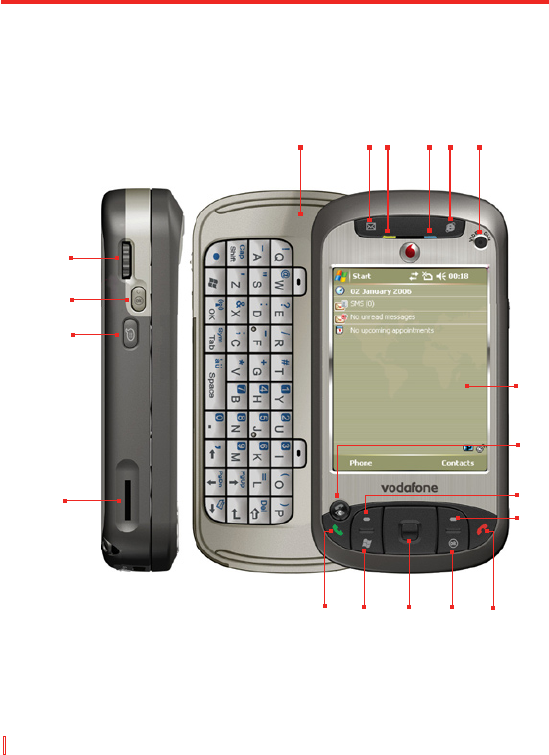
12 | Getting Started
1.1 Getting to Know Your Device and Its
Accessories
2 53 4 6
1
8
10
9
7
11
12
13
14
16 17 1815
19

Getting Started | 13
No. Item Function
1 Hardware Keyboard See Chapter 2 for details.
2 MESSAGING Button Press to quick start your Messaging.
3 Notification LED 1 This LED shows a blinking Blue light for
Bluetooth system notification of powered-up and
ready to transmit radio frequency signal, and a
blinking Green light for Wi-Fi status. When both
Bluetooth and Wi-Fi are enabled, their lights blink
alternately.
4 Notification LED 2 This bi-color LED shows Green and Amber lights
for UMTS/GSM standby, UMTS/GSM message,
UMTS/GSM network status, notification, and
battery charging status.
5 INTERNET
EXPLORER Button
Press to launch Internet Explorer.
6 Second Camera Use this video camera for video call
conversations.
7 Jog Wheel When in the Today screen or using applications,
scroll up or down to navigate through menus,
program instructions; press the wheel to carry out
selection. During a call or playing music, scroll
up or down to adjust the sound volume. When
receiving an incoming call, scroll down to silence
the audio notification.
8 OK Button Press to confirm your data entries, or to exit the
program in use.
9 VOICE COMMAND Press to start Voice Speed Dial; press and hold to
record a voice note.
10 Micro SD Card Slot In this card slot, insert a Micro SD memory card
for storing data, or insert a Micro SD input/output
card such as a network card.
11 Touch Screen Tap the screen with the stylus to write, draw, or
make a selection.
12 VIDEO CALL Button After entering a phone number in the Phone
program, press this button to start a video call.
13 Left SOFT KEY Press to execute the command shown in the label
above the button.

14 | Getting Started
No. Item Function
14 Right SOFT KEY Press to execute the command shown in the label
above the button.
15 TALK Button Press to answer an incoming call or dial a
number.
16 START Button Press to open the Start menu.
17 Navigation Control/
ENTER
Press this multi-directional control up, down, left,
or right to move through menus and program
instructions; carry out the selection by pressing
the center button; press and hold a selection to
choose option(s) from the shortcut menu.
18 OK Button Press to confirm your data entries, or to exit the
program in use.
19 END Button Press to end a call or to return to the Today
screen.
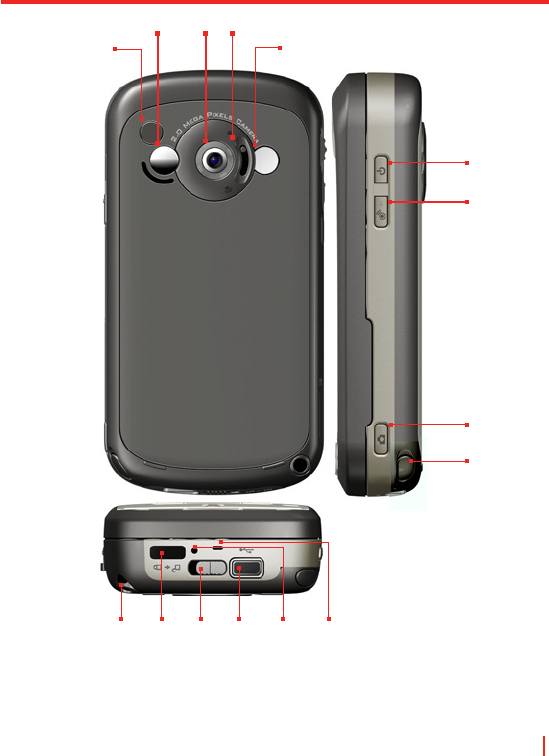
Getting Started | 15
20
21 22 23
24
25
26
27
28
333230 3429 31

16 | Getting Started
No. Item Function
20 Car Antenna
Connector
Connect your phone to the car antenna while in a
car to have better reception quality.
21 Self-Portrait Mirror Turn the back side of your device to face yourself
so that your image reflects on the mirror when
taking self-portrait shots.
22 Main Camera This camera takes still photos and records video
clips. It provides two shooting modes: Normal
mode and Macro (close-up) mode.
23 Shooting Mode
Switch
Push the switch up for Normal mode or down for
Macro mode.
24 Flash Light When turned on, it illuminates your subject and
allows you to capture clear photos or video even
in a dark environment. It also flashes when a
photo is taken.
25 POWER Button Press to turn off your device temporarily. This
switches your device to sleep mode. To turn it off
completely, press and hold (for about 5 seconds).
You can still receive calls and messages even
when your device is in sleep mode. When you
turn off the device completely, all functions
including the phone will be unavailable for use.
26 COMM MANAGER
button
Press to launch Comm Manager.
27 CAMERA Button Press to launch the camera; press again to take
a photo or video clip, depending on the specified
capture mode.
28 Stylus Use the stylus to write, draw, or select items on
the touch screen.
29 Strap Holder It lets you attach a strap for carrying your device.
30 Infrared Port It lets you exchange file(s) or data with other
devices wirelessly.
31 Battery Cover Latch Slide this latch to release the battery cover.
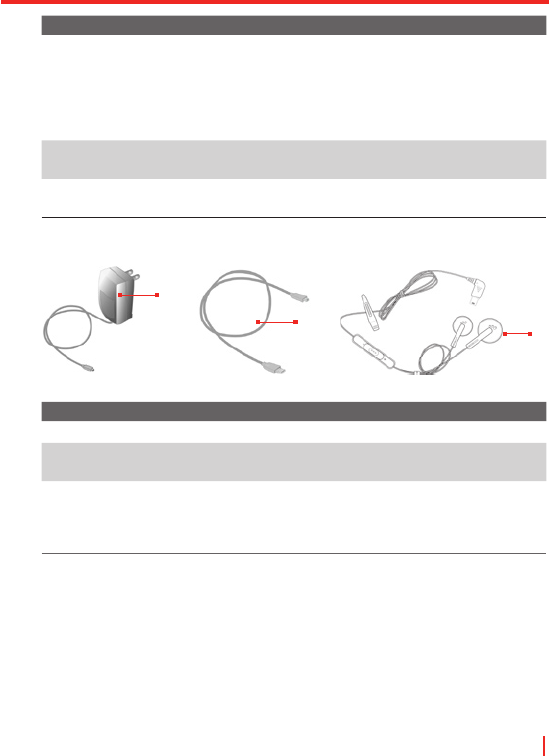
Getting Started | 17
No. Item Function
32 Sync Connector/
Earphone Jack
Use this connector to synchronize data by
connecting the provided USB Sync cable or to
recharge the battery via the provided AC adapter.
You can also connect the provided USB stereo
headset for hands-free conversation or for
listening to audio media.
33 RESET Button With the stylus, press the RESET button to soft-
reset your device.
34 Microphone Speak into the microphone when receiving or
making a phone call or voice recording.
Accessories
1
23
No. Accessory Function
1 AC adapter Converts AC to DC for recharging the battery.
2 USB Sync cable Connects your device to a PC and synchronize
data.
3 Stereo headset Provides a volume control slider and a Send/End
button. Press the Send/End button to pick up a call
or put a call on hold; press and hold the button to
end the call.

18 | Getting Started
1.2 About the USIM/SIM Card and Battery
Always turn off your device before installing/replacing the battery
and USIM/SIM card. Follow the instructions in the Quick Start Guide
to install a 3G USIM (Uinversal IC Card) or a GSM SIM (Subscriber
Identity Module) card provided by your local network service provider
and to install the battery.
The USIM/SIM card contains your phone number, service details, and
phonebook/message memory. Your device supports both 1.8V and 3V
USIM/SIM cards. Some legacy SIM cards will not function within your
device. You should consult with your service provider for a replacement
SIM card. There may be fees for this service.
Your device contains a rechargeable Li-ion polymer battery. This
device is designed to use only manufacturer-specified original batteries
and accessories. Battery performance depends on many factors,
including your wireless service provider’s network configuration, signal
strength, the temperature of the environment in which you operate your
device, the features and/or settings you select and use, items attached
to connecting ports, and your voice, data, and other program usage
patterns.
Battery life estimates (approximations):
• Standby time: up to 200 hours for GSM; 180 ~ 250 hours for
UMTS.
• Talk time (Screen off): 4 ~ 5 hours for GSM; 2 ~ 4 hours for
UMTS.
Warning! To reduce risk of fire or burns:
• Do not attempt to open, disassemble, or service the battery pack.
• Do not crush, puncture, short external contacts, or dispose of in fire or
water.
• Do not expose to temperatures above 60oC (140oF).
• Replace only with the battery pack designated for this product.
• Recycle or dispose of used battery as stipulated by local regulation.
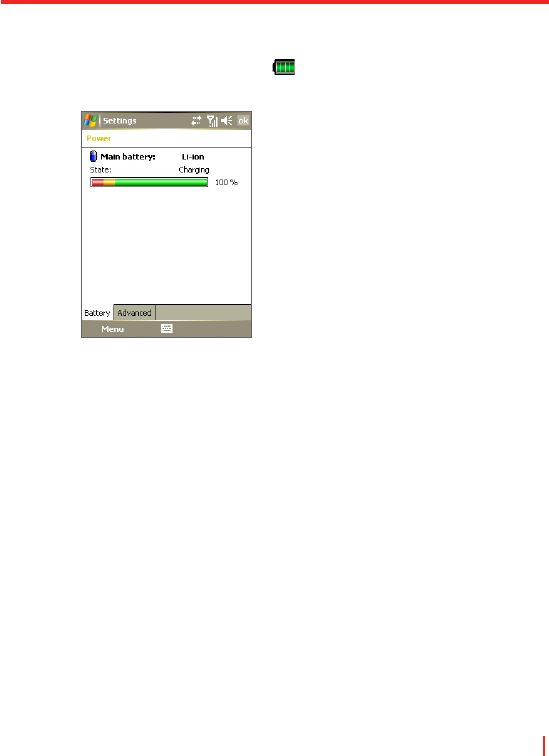
Getting Started | 19
To check the battery power
Do one of the following:
• Tap the battery level icon ( ) on the Today screen.
• Alternatively, tap Start > Settings > Systems tab > Power.
Power Information
Charge the battery
New batteries are shipped partially charged. Before you start using
your device, it is recommended that you install and charge the battery.
Some batteries perform best after several full charge/discharge cycles.
You can charge the battery in two ways:
•
Connecting your device directly to an external power source.
• Connecting your device to a PC via the provided USB Sync
cable.
Low battery
When the low-battery warning appears, do the following:
• Immediately save your current data.
• Synchronize with your PC or connect the power adapter to
charge the battery.
• Turn off your device.
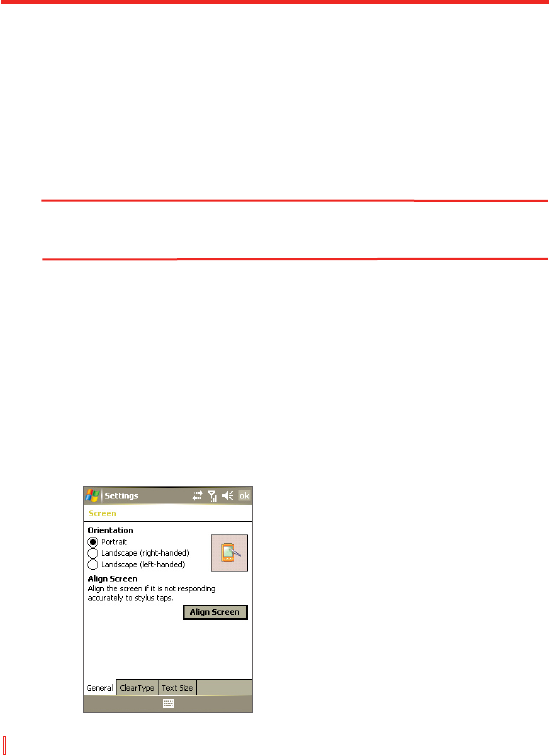
20 | Getting Started
1.3 Starting Up
Turn your device on and off
To turn on your device, press the POWER button. When you turn on
your device for the first time, you are asked to complete a calibration
process. For more information, see “Calibrate the device”.
To turn off your device, press and hold the POWER button for a few
seconds. A message will then be displayed, prompting you whether or
not to turn off the device completely.
Note Quickly pressing the POWER button turns off your device temporarily
and switches it to sleep mode. You will still be able to receive messages
and calls while your device is in sleep mode.
Calibrate the device
Calibrating the device screen involves tapping the center of a cross
with the stylus as the cross moves around the screen. This process
ensures that when you tap the screen with your stylus, the tapped item
is activated.
If your device does not accurately respond to screen taps, follow these
steps to re-calibrate it:
1. Tap Start > Settings > System tab > Screen.
2. On the General tab, tap Align Screen, then follow the on-screen
instructions to complete the calibration.
Calibrating the device
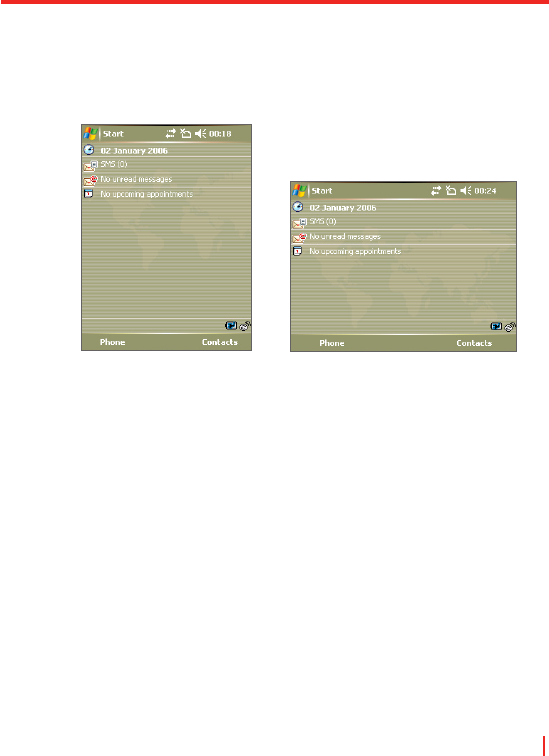
Getting Started | 21
Manage screen settings
The device’s display has three orientation modes: Portrait, Landscape
(right-handed), and Landscape (left-handed). Portrait mode allows
you to get a better view or a better operation of certain programs, while
Landscape mode may be optimal for viewing lengthy files.
Portrait mode Landscape mode
• To change the orientation, tap Start > Settings > System tab >
Screen, and select the orientation you want.
• To smooth the edges of screen fonts for many programs, on the
ClearType tab, select the Enable ClearType check box.
• To increase the readability or to see more content on the screen,
on the Text Size tab, adjust the text size by moving the slider.
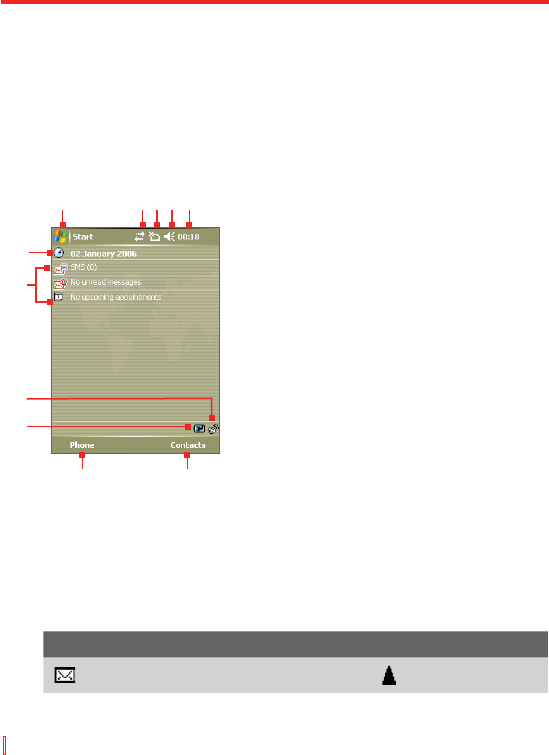
22 | Getting Started
1.4 The Today Screen
The Today screen displays important information, such as upcoming
appointments and status indicators. You can tap a section on the
screen to open the associated program.
• To access the Today screen, tap Start > Today.
• To customize the Today screen display, including the background
image, tap Start > Settings > Personal tab > Today.
Indicators
The following are some of the status icons that you may see on the
device.
Icon Description Icon Description
New e-mail or text messages; SMS
notification of voice mail Roaming
1Tap to open the Start menu.
2Tap to view connectivity status.
3Indicates the radio signal strength. Tap to
configure the phone settings.
4Tap to adjust device/ringer volume.
5Displays the current time. Tap to check the
current date and upcoming appointments.
6Displays the current date. Tap to set up
date, time, alarm, and more.
7Your day at a glance with reminders. Tap to
open the related program: Text messages,
e-mails, voice mails and appointments.
8Tap to open Comm Manager.
9Indicates the battery status. Tap to open
the Power Settings screen.
10 Tap to open the Phone screen.
11 Tap to open Contacts.
1
6
10
7
2 3 4 5
11
8
9
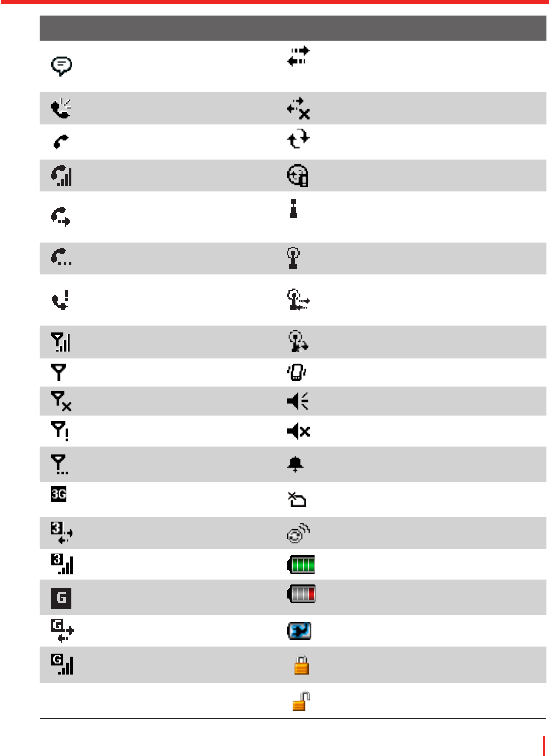
Getting Started | 23
Icon Description Icon Description
There are more
notifications. Tap the icon
to view all.
Connection is active
Speakerphone on Connection is not active
Dialing while no USIM/
SIM card is inserted Synchronization in progress
Voice call in progress Synchronization error
Calls are forwarded
Wi-Fi function enabled, but
device not connected to a
wireless network yet
Call on hold Wireless network(s) detected
Missed call
Connecting to wireless network
(arrows moving);
Connected to wireless network
Maximum signal strength. Synchronizing via Wi-Fi
No signal Ringer in vibration mode
Phone is turned off Sound on
No phone service Sound off
Searching for phone
service Alarm
3G UMTS network
available No USIM/SIM card inserted
UMTS connecting Comm Manager
UMTS in use Battery is fully charged
GPRS (General Packet
Radio Services) available Battery power is very low
GPRS connecting Battery charging
GPRS in use Device is locked
Device is unlocked
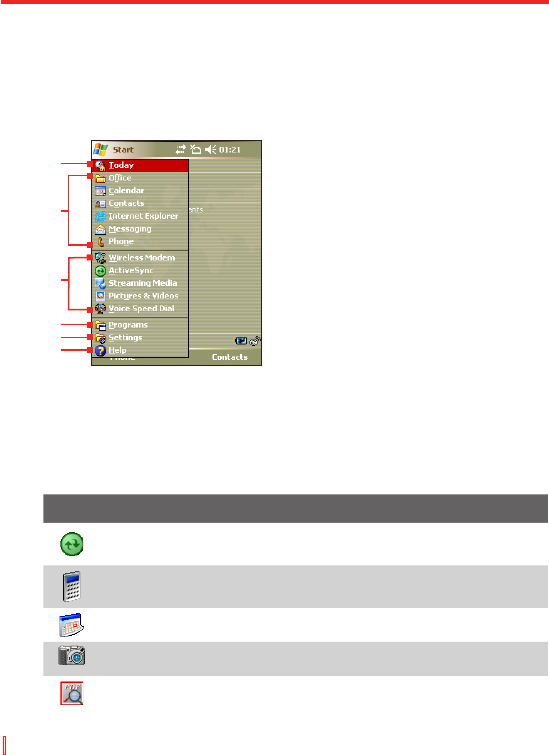
24 | Getting Started
The Start menu
The Start menu, located at the top left corner of the Today screen,
displays a list of programs. You can start a program by scrolling
through the programs list and then pressing ENTER, or by tapping a
program with the stylus.
1Tap to switch to the Today screen.
2Tap to start a program. The items
displayed in the Start menu can
be customized by tapping Start >
Settings > Personal tab > Menus.
3Tap to start a recently-used
program.
4Tap to view and select more
programs that are installed on your
device.
5Tap to change device settings.
6Tap to see a Help topic for the
current screen.
1
4
5
2
3
6
1.5 Using the Programs
The following are some of the programs that are already installed on
your device.
Icon Description
ActiveSync Synchronizes information between your device and a
PC or the Exchange Server.
Calculator Lets you perform basic arithmetic and calculations, such
as addition, subtraction, multiplication, and division.
Calendar Allows you to keep track of your appointments and create
meeting requests.
Camera Snaps photos or shoots video clips with accompanying
audio.
ClearVue PDF Enables you to view PDF files on your device.
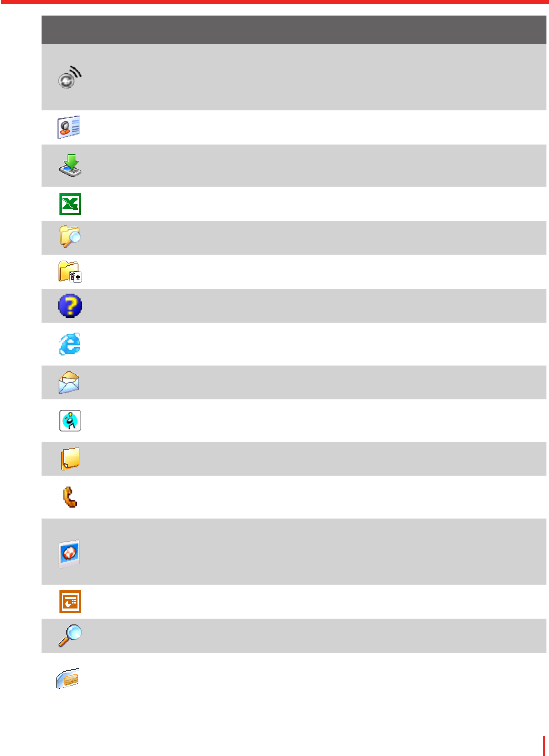
Getting Started | 25
Icon Description
Comm Manager Allows you to manage the device’s connection
(including Wi-Fi, Bluetooth, and ActiveSync), disconnect data
services (such as GPRS), turn the phone on or off, switch to ringer/
vibration mode, and enable or disable the Direct Push function.
Contacts Allows you to keep track of your friends and colleagues.
Download Agent Provides information about the download status
and the downloaded content from the Internet.
Excel Mobile Creates new workbooks or lets you view and edit
Excel workbooks.
File Explorer Enables you to organize and manage files on your
device.
Games Lets you play two pre-installed games: Bubble Breaker
and Solitaire.
Help Enables you to see Help topics for a program on your device.
Internet Explorer Allows you to browse Web and WAP sites as well
as download new programs and files from the Internet.
Messaging Allows you to send and receive e-mail, MMS, and text
messages.
MIDlet Manager Enables you to download and install Java
applications, such as games and tools, on your device.
Notes Allows you to create handwritten or typed notes, drawings,
and recordings.
Phone Lets you make and receive calls, switch between calls, and
set up conference calling.
Pictures & Videos Lets you view, organize, and sort picture and
video files on your device or a storage card. Captured photos are
stored in the My Pictures folder, and video clips are saved in the My
Videos folder of your device.
PowerPoint Mobile Lets you view PowerPoint slides and
presentations.
Search Enables you to search contacts, data, and other information
on your device.
SIM Manager Allows you to manage the contacts that are stored on
your SIM card. You can also use this program to copy SIM contents
to Contacts on your device.
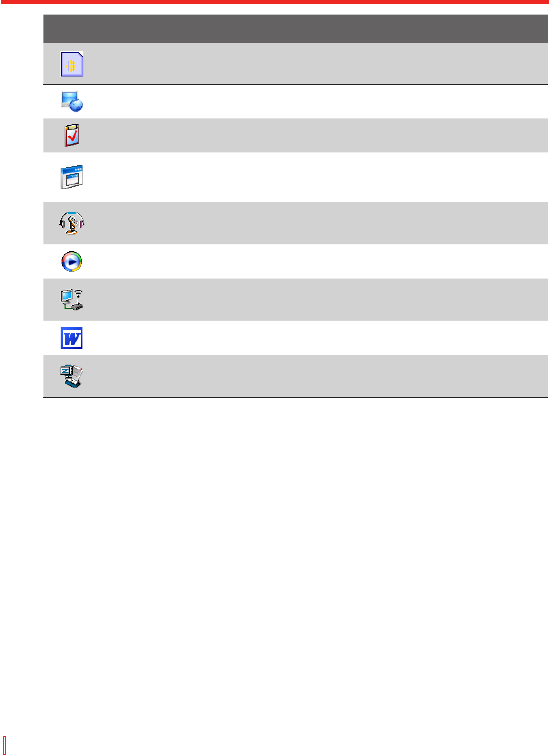
26 | Getting Started
Icon Description
STK (SIM Tool Kit) Service Allows you to access information and
other services offered by your wireless service provider.
Streaming Media Allows you to stream live or on-demand video.
Tasks Allows you to keep track of your tasks.
Terminal Services Client Allows you to log on a PC running
Terminal Services or Remote Desktop, and use all of the programs
available on that PC from your mobile device.
Voice Speed Dial Allows you to record voice tags so that you can
dial a phone number or launch programs simply by speaking a word.
Windows Media Player Lets you play back media files.
Wireless Modem Enables your.device as an external modem for a
computer via USB, Bluetooth, or infrared.
Word Mobile Lets you create, view, and edit Word documents.
ZIP Enables you to save memory and free up storage space on
your device by compressing files in the conventional ZIP format.
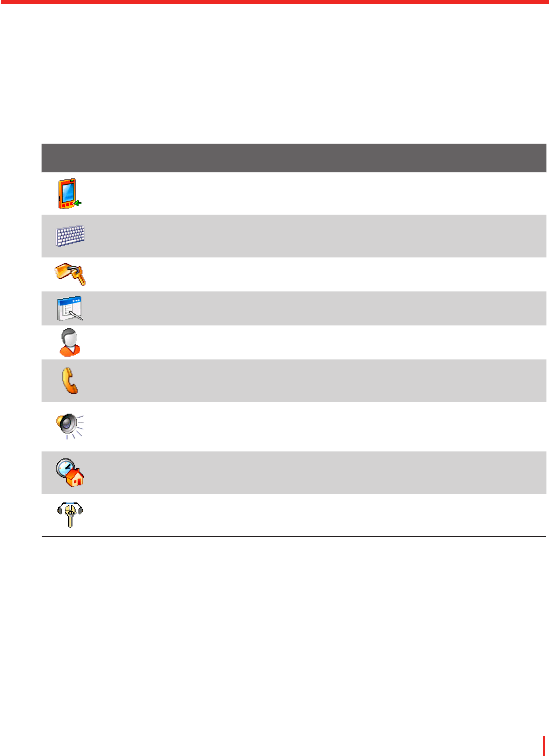
Getting Started | 27
1.6 Device Settings
You can adjust the device settings to suit the way you work. To see
all available settings, tap Start > Settings, then tap the Personal,
System, and Connections tabs located at the bottom of the screen.
Personal tab
Icon Description
Buttons Assigns a program to a hardware button.
Input Sets options for each of the input methods.
Lock Sets a password for your device.
Menus Sets what programs will appear in the Start menu.
Owner Information Allows you to enter your personal information
on your device.
Phone Allows you to customize phone settings such as ring tone,
set a PIN number for your SIM card, and more.
Sounds and Notifications Enables sounds for events,
notifications, and more, and allows you to set the type of notification
for different events.
Today Allows you to customize the appearance and the information
to be displayed on the Today screen.
Voice Speed Dial Allows you to create voice tags for voice dialing
contacts and SIM contacts as well as for launching programs.
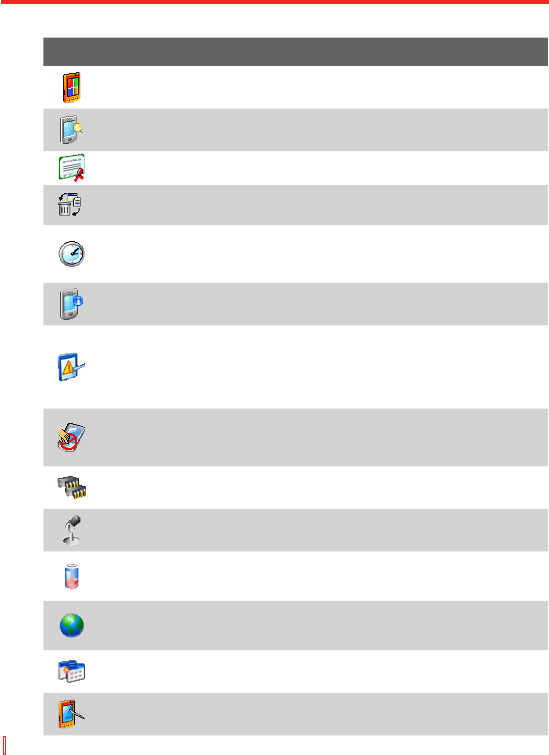
28 | Getting Started
System tab
Icon Description
About Allows you to specify a name for your device. Also shows the
Windows Mobile version and copyright information.
Backlight Sets the backlight timeout and brightness.
Certificates Shows information about certificates that are installed
on your device.
Clear Storage Removes all your data and files from the memory
and resets your device to factory default settings.
Clock & Alarms Switches the device clock to the date and time of
your locale or to a visiting time zone when you're traveling. Alarms
can also be set at specified days and times of a week.
Device Information Shows information about the firmware version,
hardware, identity, and the duration of calls made on your device.
Error Reporting Enables or disables the device's error reporting
function. When this function is enabled and a program error occurs,
technical data about the state of the program and your computer will
be logged in a text file and delivered to Microsoft's technical support
if you choose to send it.
Key Lock Locks the buttons on your device except for the POWER
button when the device is in sleep mode. This ensures you will not
switch the device on by accident and consume unnecessary power.
Memory Shows the device memory allocation status and memory
card information. Also allows you to stop currently running programs.
Microphone AGC Adjusts the volume of your voice automatically
when you are recording.
Power Shows the current battery level. Also allows you to set the
timeout for turning off the display (switching device to sleep mode)
to conserve battery power.
Regional Settings Sets the regional language to use and the
format for displaying numbers, currency, date, and time on your
device.
Remove Programs Lets you remove programs that you installed
on your device.
Screen Allows you to change the screen orientation, re-calibrate
the screen, and change the screen text size.
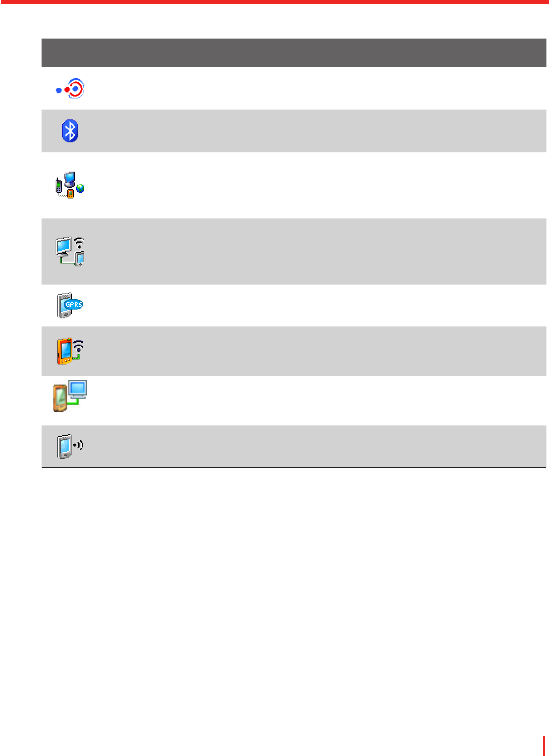
Getting Started | 29
Connections tab
Icon Description
Beam Enables your device to receive incoming infrared and
Bluetooth beams.
Bluetooth Turns Bluetooth on, sets your device to discoverable
mode, and allows you to scan for other Bluetooth devices.
Connections Sets up one or more types of modem connections for
your device, such as phone dial-up, GPRS, Bluetooth, and more,
so that your device can connect to the Internet or a private local
network.
CSD Line Type Sets the line type to use when making a circuit
switch data (CSD) connection. Normally, you do not need to change
the setting unless you encounter a problem on establishing a
connection.
GPRS Setting Sets the GPRS authentication method. Consult your
wireless service provider first before changing this setting.
Network Cards Allows your device to scan for available wireless
networks. Also allows you to set up a network card (if you have one
inserted on your device).
Enhances the connection between the device and the computer, in
situations when ActiveSync on the computer is unable to detect the
device.
Wireless LAN Shows information about the active wireless
network, and allows you to customize Wi-Fi settings.

30 | Getting Started

2.1 Using the Hardware Keyboard
2.2 Input Methods
2.3 Using On-screen Keyboard
2.4 Using Letter Recognizer
2.5 Using Block Recognizer
2.6 Using Transcriber
2.7 Using Symbol Pad
2.8 Using Notes to Draw, Write, and Record
Voice Notes
2.9 Searching Information
Chapter 2
Entering and Searching
Information
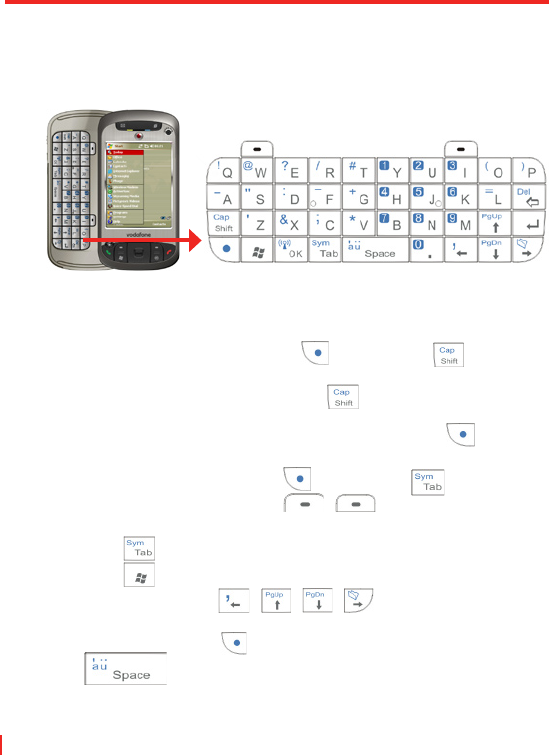
32 | Entering and Searching Information
2.1 Using the Hardware Keyboard
Your device provides you with a QWERTY keyboard, which is similar to
a standard keyboard on your PC. To use the QWERTY keyboard, slide
the screen panel to the right to reveal the keyboard.
You can do the following with the QWERTY keyboard:
• To type lowercase letters, press the keys using your thumbs or fingers.
• To use all uppercase letters, press first, then press To change
back to all lowercase letters, press these buttons again.
• To use a single uppercase letter, press and then press the
corresponding key.
• To enter a number or symbol (labeled in blue color), press and then
press the corresponding key.
• To open the Symbol Pad, press and then press .
• Press the Left/Right SOFT KEY / to perform the command
shown in the label above the key.
• Press to verify your data entries or exit the program in use.
• Press to open the Start menu.
• Press the arrow keys / / / for directional movement.
• To type accented characters (like á, ã, ç, ê, í, ó,
ü, etc), press the letter
key first and then, hold
and at the same time press the space bar
several times until you find the correct character you need.
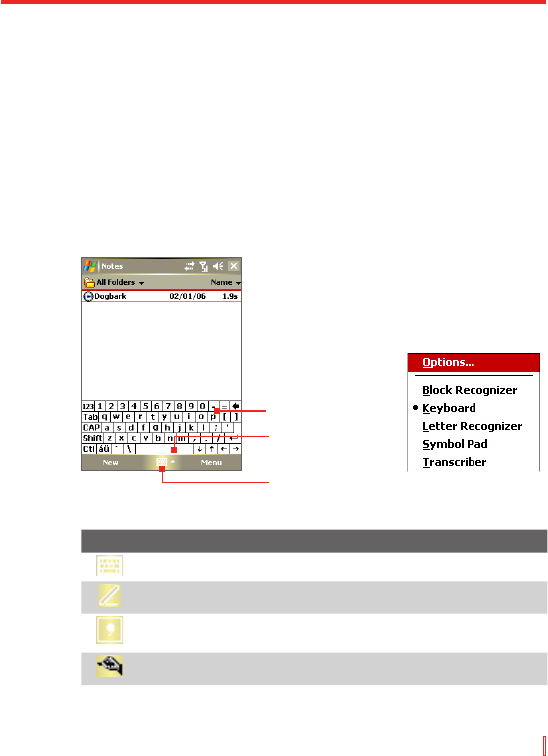
Entering and Searching Information | 33
2.2 Input Methods
When you start a program or select a field that requires text or
numbers, the Input Panel automatically becomes available. The Input
Panel provides access to the various input methods available on your
device, including Block Recognizer, Keyboard, Letter Recognizer,
Symbol Pad, and Transcriber. By default, the Input Panel icon
appears on the menu bar to indicate which input method is currently
selected. The Input Selector arrow (appearing at the right side of the
Input Panel icon) opens a list of available input methods.
To show or hide the Input Panel
• Tap the Input Panel icon on the menu bar.
Input Panel
(Keyboard)
Input Selector
arrow
Input Panel
icon Input Methods menu
Icon Input method
The on-screen keyboard.
Letter Recognizer or Block Recognizer.
Symbol Pad
Transcriber

34 | Entering and Searching Information
2.3 Using On-screen Keyboard
The on-screen Keyboard is available when text entry is possible. You
can enter text by tapping keys on the keyboard that are displayed on
the screen.
To enter text using the on-screen Keyboard
1. In a program, tap the Input Selector arrow, and tap Keyboard.
2. Enter text by tapping keys on the on-screen Keyboard.
To enlarge the on-screen Keyboard
1. Tap the Input Selector arrow, then tap Options.
2. In the Input method list, select Keyboard.
3. Tap Large keys.
2.4 Using Letter Recognizer
With Letter Recognizer, you can write individual letters, numbers, and
punctuation, which are then converted into typed text.
To use Letter Recognizer
1. From a program, tap the Input Selector arrow, and tap Letter
Recognizer.
2. Write characters, numbers, and symbols in the designated writing
area.
• Enter capital letters by writing in the ABC (left) area of the
box.
• Enter lower case letters by writing in the abc (middle) area of
the box.
• Enter numbers by writing in the 123 (right) area of the box.
• Enter punctuation and symbols by tapping in either area of the
box and then writing the desired character.
Note Letter Recognizer is available when text entry is possible.
Tip For help with writing characters, tap the question mark near the writing
area.

Entering and Searching Information | 35
2.5 Using Block Recognizer
With Block Recognizer, you use a single stroke to write letters,
numbers, symbols, and punctuation, which are then converted into
typed text.
To use Block Recognizer
1. From a program, tap the Input Selector arrow, and tap Block
Recognizer.
2. Write characters, numbers, and symbols in the designated writing
area.
• Enter letters by writing in the abc (left) area of the box.
• Enter numbers by writing in the 123 (right) area of the box.
• Enter symbols and punctuation by tapping in either area of the
box and then writing the desired character.
Note Block Recognizer is available when text entry is possible.
Tip For help with writing characters with Block Recognizer, tap the
question mark near the writing area.
2.6 Using Transcriber
Transcriber is a handwriting recognition program that allows you to
write in cursive, print, or a combination of both. Transcriber works
transparently in the background of programs, recognizing words with
its integrated dictionary. When Transcriber is turned on, it interprets
stylus movement anywhere on the screen as handwriting input. For
more information about using Transcriber, see Help on your device.
To start Transcriber
1. Start a program that accepts user input, such as Word Mobile.
2. Tap the Input Selector arrow, and tap Transcriber. The
Transcriber introductory screen appears.

36 | Entering and Searching Information
To write using Transcriber
1. In a program, position the cursor where you want text to appear.
2. Use the stylus to write anywhere on the screen. The handwriting
will be converted to text shortly after you lift the stylus from the
screen.
To enter punctuation and symbols
Transcriber comes with an on-screen keyboard that provides an easy
way to add punctuation or a special symbol to existing text.
• From a program, tap on the Transcriber toolbar.
The keyboard remains visible until you tap the button again.
Tips • To reposition the keyboard, tap and hold the title bar, then drag to the
desired location.
• When no text is selected, you can also open the keyboard by
doing the gesture. For more information about using Transcriber
gestures, see Help on your device.
To edit text
1. In a program, draw a line across the text you want to edit.
2. After you lift the stylus from the screen, the line will disappear and
the selected text will be highlighted.
3. Do either of the following:
• Rewrite the text.
• Use gestures to capitalize letters, insert a space, and so on.
For information about using Transcriber gestures, see Help on
your device.
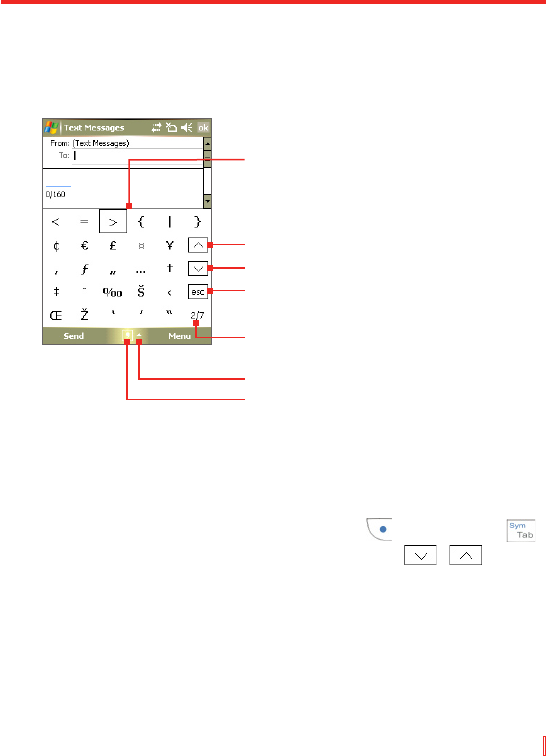
Entering and Searching Information | 37
2.7 Using Symbol Pad
Symbol Pad provides a comprehensive list of common symbols
such as parentheses, braces, currency signs, and more, as well as
punctuation marks and special characters.
Tap to display the previous page of symbols.
Tap to display the next page of symbols.
Input Selector arrow
Tap a symbol to select it.
When using the Navigation Control or the
hardware keyboard, press UP, DOWN, LEFT,
or RIGHT to navigate through the available
symbols on-screen, then press ENTER to
select a symbol.
Tap to close the Symbol Pad without selecting
any symbol.
Symbol Pad icon
This indicates the current page and the total
number of symbol pages.
To open the Symbol Pad and select a symbol
1. Create or open a document, such as a Word document.
2. To open the Symbol Pad:
• Tap the Input Selector arrow, then tap Symbol Pad; or
• Using the hardware keyboard, press and then press .
3. To browse through the pages of symbols, tap / on the
Symbol Pad screen.
4. Tap a symbol to select it and close the Symbol Pad. The selected
symbol will then be inserted in your document.

38 | Entering and Searching Information
2.8 Using Notes to Draw, Write, and Record
Voice Notes
Using Notes, you can draw directly on the screen, or write on the
screen and save notes in your own handwriting. You can also create
a stand-alone recording (voice note) or you can add a recording to a
note.
For more information on what you can do with Notes, see “Notes” in
Chapter 7.
2.9 Searching Information
You can search for files and other items stored in My Documents folder
or on an installed storage card of your device. You can search by file
name or by words located in the item. For example, you can search in
e-mail messages, notes, appointments, contacts, and tasks, as well as
in online Help.
To search for a file or an item
1. Tap Start > Programs > Search.
2. In the Search for field, you can:
• Enter the file name, word, or other information you want to
search for.
• Tap the down arrow icon ( ), and from the list, select one
item that you have looked for before.
3. In the Type field, you can tap the down arrow icon ( ) and
select a data type from the list to help narrow your search.
4. Tap Search. The system start searching the matched files in My
Documents folder and subfolders.
5. In the Results list, tap the item you want to open.
Note The storage card symbol is displayed next to the names of files
saved on a storage card.

3.1 Using the Phone
3.2 Making a Call
3.3 Receiving a Call
3.4 Making a Video Call
3.5 Receiving a Video Call
3.6 Smart Dialing
3.7 In-call Options
3.8 Additional Dialing Information
Chapter 3
Using Phone Features
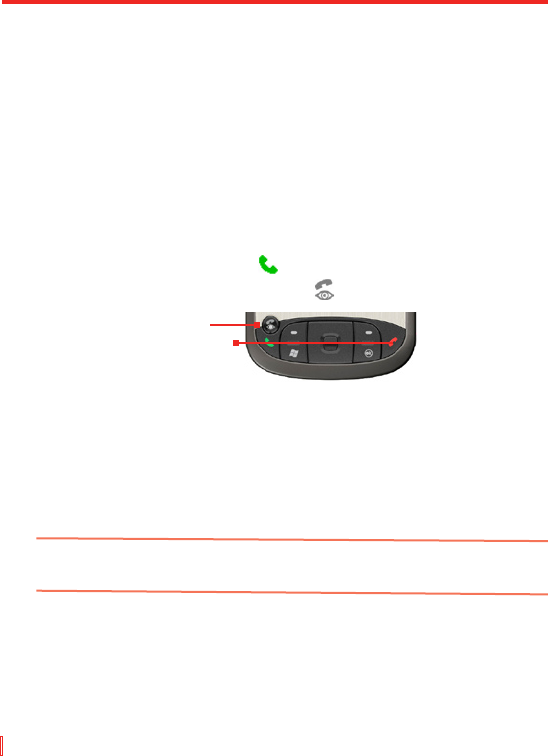
40 | Using Phone Features
3.1 Using the Phone
Like a standard mobile phone, you can use your device to make,
receive, and keep track of calls and send SMS/MMS messages. You
can also dial directly from Contacts, and easily copy phonebook entries
from your SIM card to Contacts on your device.
The Phone screen
From the Phone screen, you can access Call History, Speed Dial, and
Phone settings. To open the Phone screen, do one of the following:
• Tap Phone on the Today screen.
• Tap Start > Phone.
• Press the TALK button ( ).
• Press the VIDEO CALL button ( ).
TALK button
VIDEO CALL button
Enter your PIN
Most SIM cards are preset with a PIN (personal identification number)
that is provided by your wireless service provider. You need to enter
the PIN whenever you use your device.
1. Enter the preset PIN assigned by your wireless service provider.
2. Tap Enter.
Note If your PIN is entered incorrectly three times, the SIM card will be
blocked. If this happens, you can unblock it with the PUK (PIN
Unblocking Key) obtained from your wireless service provider.
Turn the phone function on and off
In many countries, you are required by law to turn off your phone while
on board an aircraft. Turning off the power does not turn off the phone
function.
To turn off the phone function, do one of the following:
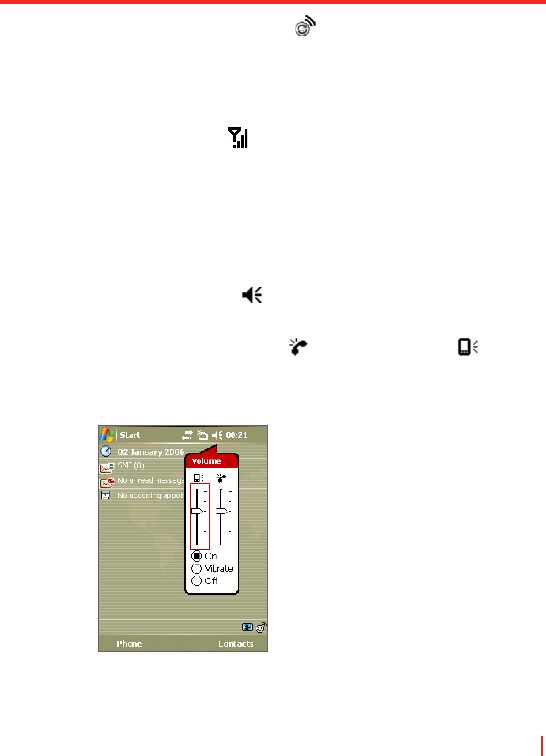
Using Phone Features | 41
• Tap the Comm Manager icon ( ) on the Today screen. On the
Comm Manager screen, tap the Phone button to turn off the
phone function.
To resume call function, turn on the phone function by tapping the
Phone button again on the Comm Manager screen.
• Tap the Signal icon ( ) then tap Turn on flight mode. This
disables all wireless radios on your device, which include the
phone function, Bluetooth, and Wi-Fi.
To resume call function, tap the Signal icon again then tap
Turn off flight mode. This also restores the previous state of
Bluetooth, but keeps Wi-Fi disabled.
Adjust the device volume
1. Tap the Speaker icon ( ).
2. Under Volume, do the following:
• Adjust the phone volume ( ) or device volume ( ) by
moving the slider to the desired volume level.
• Tap On, Vibrate, or Off to change both the system and ringer
volume settings.
Volume adjustment
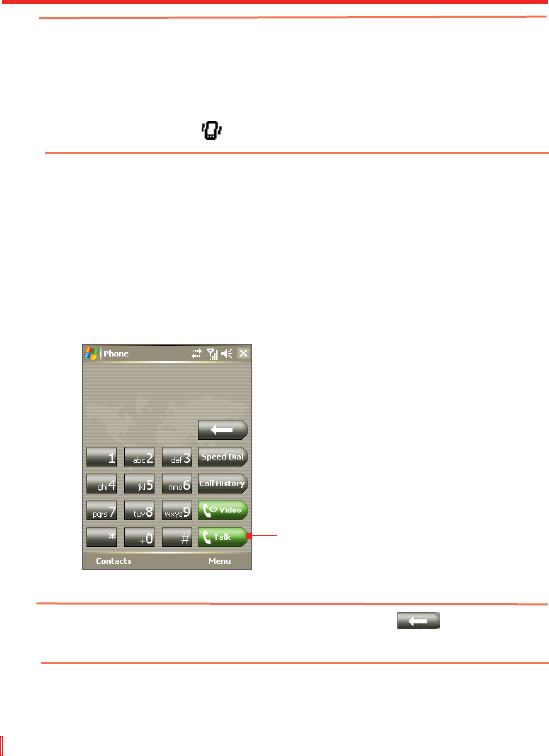
42 | Using Phone Features
Notes •
To adjust the conversation phone volume, you must do it during a call.
Adjusting the volume at another time will affect the ring, notification,
and MP3 sound levels.
•
When you activate Vibrate mode, sound will automatically be muted
and your device will vibrate when an incoming call is received. The
Vibrate icon ( ) will appear in the title bar to indicate that Vibrate
mode is activated.
3.2 Making a Call
With your device, you can make a call from Phone, Contacts, Speed
Dial, Call History, and SIM Manager.
Make a call from Phone
1. Tap Phone or Start > Phone on the Today screen.
2. On the Phone screen, tap the desired phone number, and tap
Talk.
Talk button
Phone screen
Tip If you tap a wrong number, tap the Back arrow ( ) to erase each
subsequent digit of a number. To erase the entire number, tap and hold
the Back arrow.

Using Phone Features | 43
Make a call from Contacts
Tap Contacts or Start > Contacts on the Today screen, and do one of
the following:
• Press NAVIGATION up or down to select a contact, and press
TALK twice (once to send the number to the Phone keypad, and
once to dial the number).
• Tap the desired contact in the contacts list, and tap the phone
number that you want to call.
• Tap and hold the desired contact, and on the shortcut menu, tap
Call Work, Call Home, or Call Mobile.
To choose one of the numbers of a contact to dial
By default, the mobile telephone number (m) of a contact is dialed
when you make a call from Contacts. However, you can specify that a
different phone number is dialed instead.
1. Tap Contacts or Start > Contacts on the Today screen.
2. Press NAVIGATION up or down to select the contact.
3. Press NAVIGATION left or right. The letters representing the
number will change as you scroll through them.
Make a call from Call History
1. On the Phone screen, tap Call History.
2. Tap Menu > Filter and tap a category.
3. Scroll to the desired contact or phone number, and tap Call.
Make a call from Speed Dial
Use Speed Dial to call frequently-used numbers with a single tap. For
example, if you assign a contact to the location 2 in Speed Dial, you
can simply tap and hold on the Phone screen to dial the contact’s
number. To create a Speed Dial entry for a phone number, make sure
the number already exists in Contacts.

44 | Using Phone Features
To create a Speed Dial entry
1. On the Phone screen, tap Speed Dial.
2. Tap Menu > New.
3. Tap a contact. Select the phone number that you want to add to
Speed Dial.
4. In the Location box, select an available location for the new
Speed Dial entry.
Note Location 1 is generally reserved for your voice mail, and Speed Dial will
designate the next available location by default. If you want to place a
phone number in a position that is already occupied, the new number
will replace the number that is already there.
Tips •
To create a Speed Dial entry from Contacts, tap and hold the contact
name, tap Add to Speed Dial, then select the phone number for
which to create a Speed Dial and an available location for the new
Speed Dial entry.
•
To delete a Speed Dial entry, in the Speed Dial list, tap and hold the
desired entry, and tap Delete.
Make a call from SIM Manager
SIM Manager allows you to view the contents of your SIM card,
transfer SIM phonebook entries to Contacts on your device, and make
a call from your SIM card.
To call a SIM contact
1.
Tap Start > Programs > Tools > SIM Manager. Wait for your SIM
card contents to load
.
2. Tap and hold the name or phone number of the person you want
to call, and tap Call.

Using Phone Features | 45
3.3 Receiving a Call
When you receive a phone call, a message will appear, giving you the
option to either answer or ignore the incoming call.
To answer or reject an incoming call
• To answer the call, tap Answer, or press TALK on the device.
• To reject the call, tap Ignore, or press END on the device.
To end a call
Once an incoming or outgoing call is in progress, you can tap End or
press END on the device to hang up.
3.4 Making a Video Call
Your device allows you to make video calls when you are within a 3G
network coverage area. You need to use a 3G enabled SIM card to
make video calls.
To make a video call
• Press the VIDEO CALL button ( ) on your device to open the
Phone screen. On the Phone keypad, tap the phone number
to call, then press the VIDEO CALL button ( ) again or tap
to start a video call.
• From Contacts, tap and hold the desired contact, and tap Video
Call.
• From Call History, tap and hold the desired phone number or
contact, and tap Video Call.
• In Inbox, the embedded phone number in the SMS or e-mail
message will be highlighted, so that you can press the VIDEO
CALL button ( ) to make a video call.
Note The other party’s image will appear on the screen about 3 to 5 seconds
after a connection is established, depending on the signal strength. The
streaming images quality may also be influenced by the signal.
When the video call is unsuccessful, a message pops up asking you if
you want to try again, make a voice call instead, or send an SMS/MMS
message.
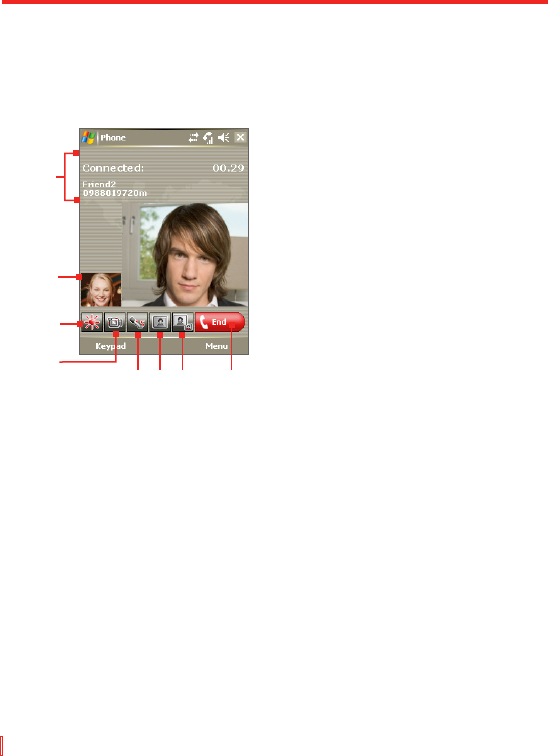
46 | Using Phone Features
Change Video Call settings
While on a video call, you can change certain settings such as the size
of the image, brightness of the image, the camera to use, and more.
The following shows the Video Call screen and control buttons during
an ongoing call.
2
3
4
5 6 7 8
1
1Status area. Displays your service provider name, the other party's
information, and call timer.
2Image display area. Displays your image and the other party's image,
depending on the selected Swap Image setting.
3Brightness Control. Tap to adjust the camera’s brightness.
4Camera On/Off. Tap to toggle between turning on/off the camera. When
the camera is turned off, the image displayed depends on the Video Call
options you have set. See “Set up Video Call Options” for details.
5Audio Mute/Unmute. Tap to mute/unmute audio.
6Main/Second camera. Tap to toggle between using the Main (back) and
Second (front) camera.
7Swap Image. Tap continuously to cycle through the available image display
options.
8End. Tap to end the video call.
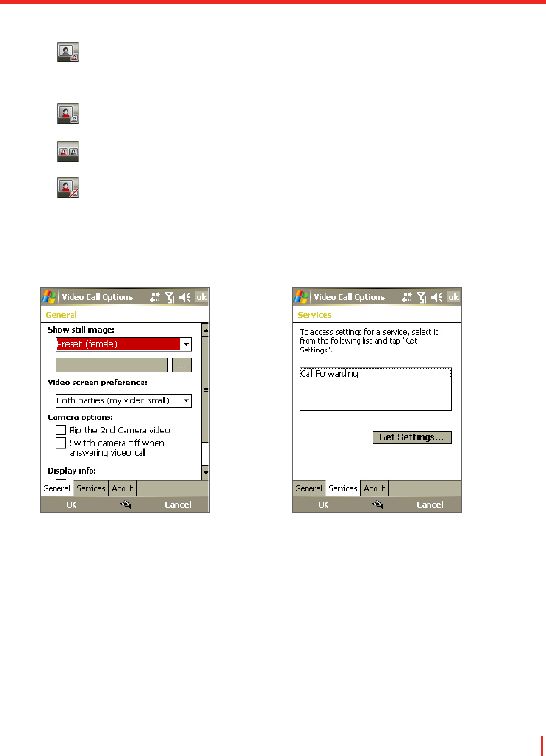
Using Phone Features | 47
Swap Image options
Both parties (My video small) The other party's image is large
while your image is small. This is
the default setting.
Both parties (My video large) The other party's image is small
while your image is large.
Both parties (equal) Both your image and the other
party appear the same size.
Other party only
Only the other party's image is
displayed.
Set up video call options
On the Phone screen, or on the screen of the ongoing video call, tap
Menu > Video Call Options. You can set the following options:
Video Call Options: General tab Video Call Options: Services tab
General tab
• Show still image. Select the image you want to display when
you turn off the camera.
• Preset (female). Displays a female picture provided by your
service provider.
• Preset (male). Displays a male picture provided by your
service provider.
Change Video Call settings
While on a video call, you can change certain settings such as the size
of the image, brightness of the image, the camera to use, and more.
The following shows the Video Call screen and control buttons during
an ongoing call.
2
3
4
5 6 7 8
1
1Status area. Displays your service provider name, the other party's
information, and call timer.
2Image display area. Displays your image and the other party's image,
depending on the selected Swap Image setting.
3Brightness Control. Tap to adjust the camera’s brightness.
4Camera On/Off. Tap to toggle between turning on/off the camera. When
the camera is turned off, the image displayed depends on the Video Call
options you have set. See “Set up Video Call Options” for details.
5Audio Mute/Unmute. Tap to mute/unmute audio.
6Main/Second camera. Tap to toggle between using the Main (back) and
Second (front) camera.
7Swap Image. Tap continuously to cycle through the available image display
options.
8End. Tap to end the video call.

48 | Using Phone Features
• Custom image. Lets you use an image from file as your
display picture. When this option is selected, the File Name
box and the Browse button will be enabled, allowing you to
select an image file.
• Last video frame. Uses the last video frame before you
stopped the camera as your display image.
• Video screen preference. To change how your image and the
other party’s image are displayed on the screen, select your
preference from the Video screen preference list or tap the
Swap Image button on the Video Call screen.
• Camera options:
• Flip the 2nd camera video. Select this check box if you are
going to show a text document to the other party using the
second camera.
• Switch camera off when answering video call. Select this
check box to not send a video feed of yourself to the other
party. Instead, the option you selected in Show still image
will be displayed.
• Display info:
• Show call timer. Select this check box to display the call
period in the status area.
• Show phone number and name. Select this check box to
display the other party’s phone number and name in the status
area.
Services tab
To set up further calling options for Video Call, tap the Services tab.
On the Services screen, select the desired service from the list, then
tap Get Settings to access its settings.

Using Phone Features | 49
3.5 Receiving a Video Call
To answer or reject an incoming video call
• To answer the video call, tap Answer, or press the VIDEO CALL (
) button.
• To reject the video call, tap Ignore, or press END on your device.
To end a video call
Once an incoming or outgoing video call is in progress, you can press
END on your device, or tap End to hang up.
3.6 Smart Dialing
Smart Dialing is a program that makes it easy for you to dial a phone
number. When you start entering numbers or characters, Smart Dialing
will automatically search and sort the contact entries on the SIM
card, in Contacts, and the phone numbers in Call History (including
incoming, outgoing, and missed calls). You can then select the desired
number or contact from the filtered list to dial.
Start Smart Dialing
Open the Phone screen, then tap the keys on the Phone keypad
that correspond to the phone number or contact you want to call.
Alternatively, you can use the hardware keyboard to input.
When you start entering a number or letter, the Smart Dialing panel will
appear automatically on the Phone screen. You can change the panel
size according to your need by tapping the arrow icon .
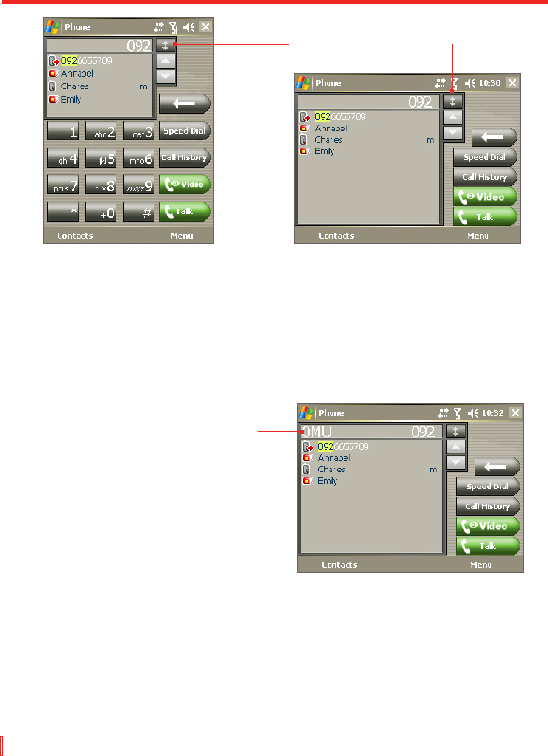
50 | Using Phone Features
Portrait view with minimized
Smart Dialing panel
Landscape view with expanded
Smart Dialing panel
Tap to minimize or expand the
Smart Dialing panel
When you use the hardware keyboard to dial a number, the digits
entered will be displayed on the right side of the entry box and the
equivalent letters will appear on the left side. Whereas tapping the
Phone keypad will display only the digits in the entry box.
Letters appear on the left
side of the entry box when typing
on the hardware keyboard

Using Phone Features | 51
Tips on using Smart Dialing
Smart Dialing starts looking for numbers or contacts that match the
sequence you have entered. Below are some tips on how to use Smart
Dialing to quickly find a desired phone number or contact.
To find a phone number
• Simply enter the first one or two digits to find a phone number in
Call History.
• Enter the first three digits or more if you want to find a phone
number from the saved contacts on your device and SIM card.
To find a contact name
You can just enter the first letter of a contact’s first name or surname.
Smart Dialing will search for the letter starting from the first character
of a contact name as well as from the character that appears after a
space, dash, or underscore in a contact name. For example, if you tap
number “2” which is associated with [a, b, c] on the Phone keypad,
contact names such as the following will be considered matches: “Ben
Miller”, “George Adams”, “John-Carter”, “Carter, Ellen”, “Dixon, Allan”,
“Thomas_Clark”, “JaneCampbell”.
If the matching list is long and you want to narrow down the search
further, enter another letter. Using the same example above, if you
continue to tap “3” which is associated with [d, e, f], the matching list
will be narrowed down to the following names: “Ben Miller”, “George
Adams”, “Carter, Ellen”, “Dixon, Allan”.
Make a call or send a text message using Smart
Dialing
1. Begin entering the first few numbers or characters.
2. In the Smart Dialing panel, browse the list by tapping the arrows
( / ) or pressing NAVIGATION up or down to select the
desired contact or phone number. When a contact is selected, it
expands to also show the corresponding phone number.
3. The highlighted item will move one line when you press
NAVIGATION up or down; the highlighted item will scroll one
page when you tap the arrows.
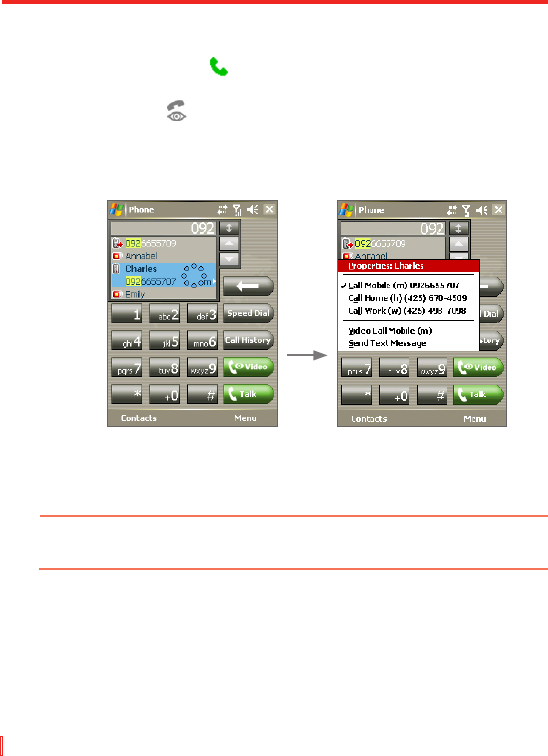
52 | Using Phone Features
4. Do one of the following:
• When the correct contact is selected, tap Talk or press the
TALK button ( ) to make a voice call.
• To make a video call, tap Video or press the VIDEO CALL
button ( ).
• To call a different phone number associated with the selected
contact, tap and hold the selected contact, and tap the phone
number you want to call.
Tap and hold the contact to pop up the shortcut menu
• To send a text message to the selected contact, tap and hold
the contact, and tap Send Text Message.
Tip
To view or edit information associated with the selected contact, tap the
contact’s name on the shortcut menu (applies only to entries stored in
Contacts on your device).
Set up Smart Dialing
1. On the Phone screen, tap Menu > Smart Dialing Options.
2. On the Options tab, select the Enable Smart Dialing check box.
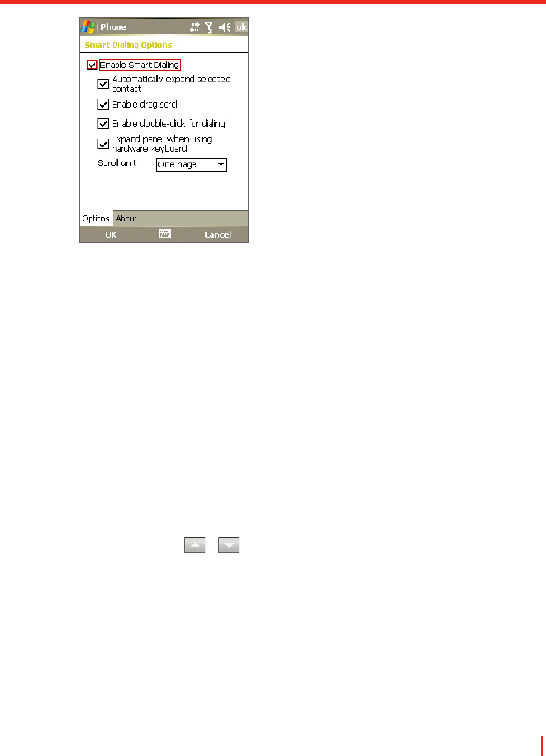
Using Phone Features | 53
Smart dialing options
• Select the Automatically expand selected contact check
box to enable a contact’s name and phone number to be
displayed when the contact is selected in the matching list.
• Select the Enable drag-scroll check box to scroll in the
matched list by dragging.
• Select the Enable double-click for dialing check box to
make a voice call by double-clicking the item in the matched
list.
• Select the Expand panel when using hardware keyboard
check box to automatically expand the Smart Dialing panel
when you are using the hardware keyboard to input.
•
In Scroll unit, you can set the amount of scrolling when tapping
the arrows
( / ).

54 | Using Phone Features
3.7 In-call Options
To put a call on hold
Your device notifies you when you have another incoming call, and
gives you the choice of rejecting or accepting the call. If you are
already on a call and accept the new call, you can choose to switch
between the two callers, or set up a conference call between all three
parties.
1. Tap Answer to take the second call, and put the first one on hold.
2. To end the second call and return to the first call, tap End or
press END on the device.
To switch between two calls
• Tap Swap.
To set up a conference call
1. Either put a call on hold, and dial a second number; or, accept a
second incoming call when you already have one in progress.
2. Tap Conference.
Note Not all service providers support conference calling. Contact your
service provider for details.
To turn on and off the Speakerphone
The built-in Speakerphone on your device allows you to talk hands-free
or lets other people listen to the conversation.
• During a call, tap Speaker On, or press and hold TALK until the
speakerphone turns on. The speakerphone icon ( ) appears in
the title bar.
• To turn off the speakerphone, tap Speaker Off, or press and hold
TALK again until the speakerphone turns off.
Warning! To avoid damage to your hearing, do not hold your device against your
ear when the Speakerphone is turned on.
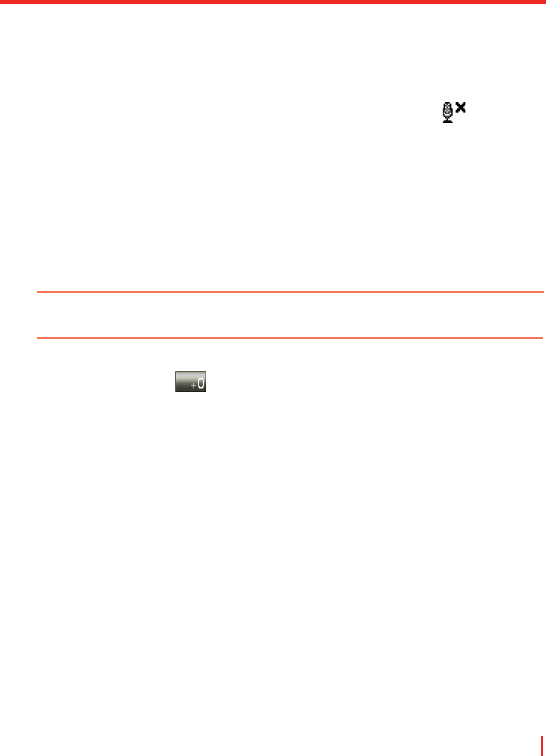
Using Phone Features | 55
To mute a call
You can turn off the microphone during a call, so that you can hear the
caller but the caller cannot hear you.
• During a call, tap Mute.
• When the microphone is turned off, the mute icon ( ) appears
on the screen. Tap Unmute to turn on the microphone again.
3.8 Additional Dialing Information
Make an emergency call
• Enter the international emergency number for your locale, and
tap Talk.
Tip Additional emergency numbers may be included in your SIM card.
Contact your service provider for details.
Make an international call
1. Tap and hold on the Phone keypad until the + sign appears.
The + replaces the international prefix of the country that you are
calling.
2. Enter the full phone number you want to dial, and tap Talk. The
full phone number includes country code, area code (without the
leading zero, if any) and phone number.

56 | Using Phone Features

4.1 Setting Up ActiveSync
4.2 Synchronizing Information
4.3 Synchronizing via Infrared and Bluetooth
4.4 Synchronizing Music, Video, and Pictures
4.5 Setting up E-mail Security
Chapter 4
Synchronizing Information and
Setting Up E-mail Security

58 | Synchronizing Information and Setting Up E-mail Security
4.1 Setting Up ActiveSync
ActiveSync synchronizes information on your device with information
on your PC, such as Outlook content. ActiveSync can also synchronize
over a wireless or cellular network with Microsoft Exchange Server,
if your company or service provider is running Microsoft Exchange
Server with Exchange ActiveSync.
Specifically, you can use ActiveSync to:
• Synchronize information such as Outlook E-mail, Contacts,
Calendar, or Tasks information, as well as media files such as
pictures, video, and music between your device and your PC.
• Synchronize Outlook E-mail, Contacts, Calendar appointments,
and Tasks on your device directly with Exchange Server so that
you can stay up-to-date even when your PC is turned off.
• Copy files between your device and your PC without
synchronizing.
• Select which types of information are synchronized and specify
how much information is synchronized. For example, you can
choose how many weeks of past Calendar appointments to
synchronize.
• Add and remove programs on your device. For details, see
Chapter 5, “Adding and Removing Programs.”
To install and set up ActiveSync on the computer
1. Install ActiveSync on your PC, as described in the Getting Started
CD.
2. After ActiveSync is installed, the Synchronization Setup Wizard
automatically starts when you connect your device to the PC.
The wizard will guide you to create a synchronization relationship
between your computer and device. Click Next.
3. Do not select the Synchronize directly with a server
running Microsoft Exchange Server check box if you want to
synchronize your device with a computer. Just click Next, then
skip to step 8.
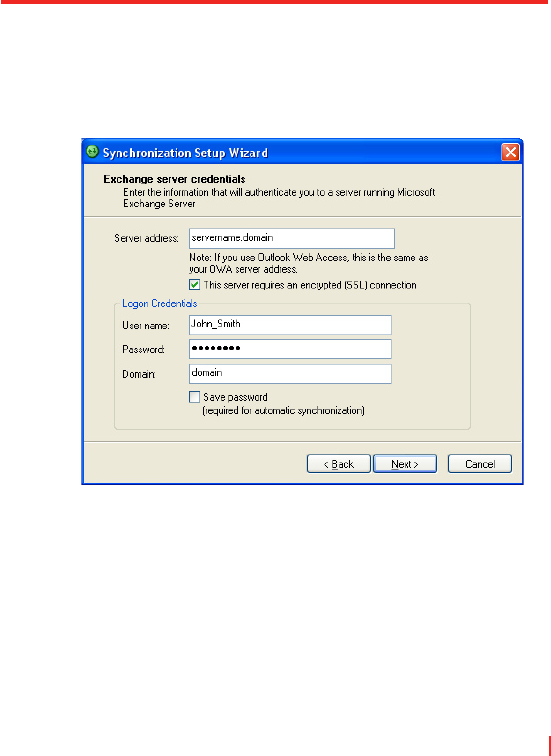
Synchronizing Information and Setting Up E-mail Security | 59
4. If you want to synchronize your device with Exchange Server,
select the Synchronize directly with a server running
Microsoft Exchange Server check box, then click Next.
5. On the Exchange server credentials screen, enter the Exchange
server address, your user name and password, and the domain
name.
If you do not know the Exchange server address and the domain
name, check with your network administrator, or do the following
to find them in your computer:
• In Outlook, click Tools > E-mail Accounts.
• Select View or change existing e-mail accounts.
• Double-click Microsoft Exchange Server.
• On the Exchange Server Settings screen, you will see the
Exchange Server name.
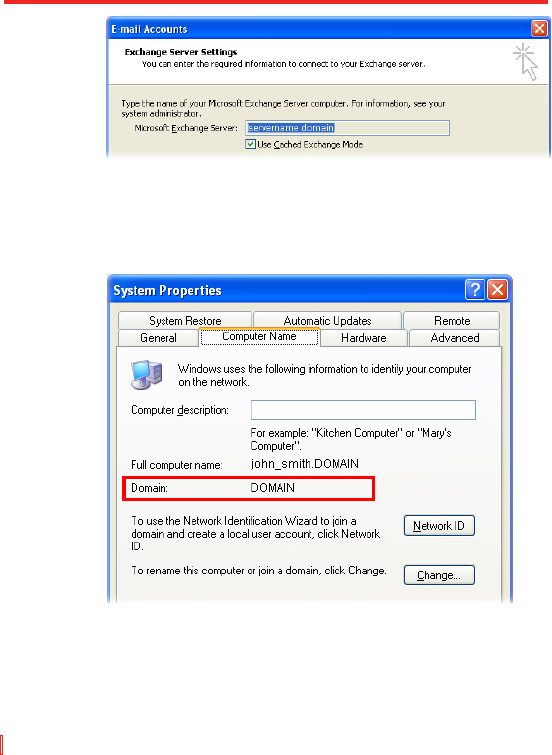
60 | Synchronizing Information and Setting Up E-mail Security
• To check the domain name, click Start > Settings > Control
Panel, then double-click System.
• In the System Properties dialog box, click the Computer
Name tab. You will then see the domain name.
6. On your device, you also need to enter the Exchange server
settings. For information about this, see “Synchronizing directly
with Exchange Server.”
7. On the Synchronization Setup Wizard, click Next.
8. Select the information types to synchronize between your device
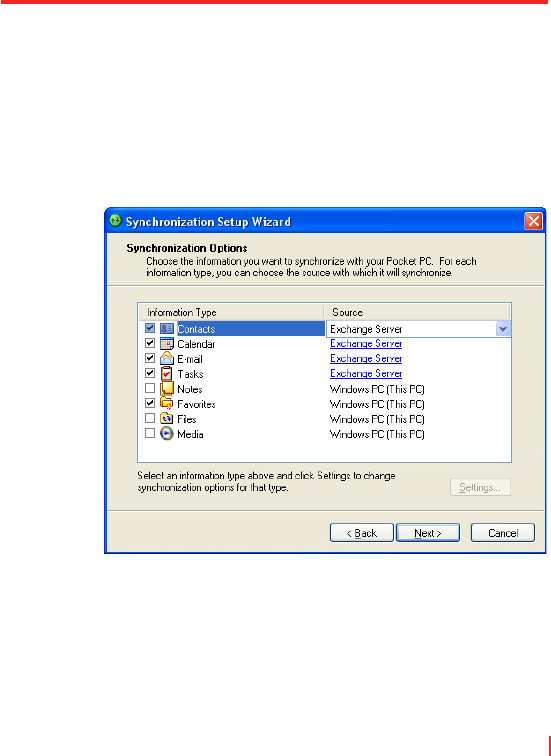
Synchronizing Information and Setting Up E-mail Security | 61
and computer.
If you want to synchronize your device with both your computer
and Exchange Server, do the following:
• For the Contacts, Calendar, E-mail, and Tasks items, choose
whether to synchronize them with the computer or with the
Exchange Server. These items cannot be synchronized to
both.
• Select the check boxes of the other information types if you
want to synchronize them with your computer.
Information types on the PC and Exchange Server
9. Click Next.
10. Click Finish.
When you finish the wizard, ActiveSync synchronizes your device
automatically. Once synchronization completes, you can disconnect
your device from your PC.

62 | Synchronizing Information and Setting Up E-mail Security
4.2 Synchronizing Information
When you connect your device to the PC using a USB cable, an
infrared connection, or a Bluetooth connection, ActiveSync will
immediately synchronize. While your device is connected, ActiveSync
synchronizes every time you make a change on either the PC or your
device.
To manually start and stop synchronization
1. Connect your device to the PC:
• To synchronize Outlook information and other local information
on the PC, including media files, connect your device to the
PC using Bluetooth, infrared (IR) or a cable.
• If you are synchronizing directly with Exchange Server, you
can use this connection to the PC to "pass through" to the
network, or you can synchronize without connecting to the PC
over a cellular network.
2. In ActiveSync, tap Sync. To end synchronization before it
completes, tap Stop.
Synchronize Outlook information with the computer
If you have set up a synchronization relationship between your device
and the PC, synchronization keeps Outlook information up-to-date on
both your device and PC.
You can also set up your device to synchronize with more than one PC
or with a combination of one or more PCs and Exchange Server. When
synchronizing with multiple computers, the items that you synchronize
will appear on all of the computers with which they are synchronized.
For example, if you have set up synchronization with two PCs (PC1
and PC2), which have different items, and you synchronize Contacts
and Calendar on your device with both computers, the result is as
follows:

Synchronizing Information and Setting Up E-mail Security | 63
Location New state
PC1 All Outlook contacts and calendar appointments that were on
PC2 are now also on PC1.
PC2 All Outlook contacts and calendar appointments that were on
PC1 are now also on PC2.
Pocket PC
Phone
All Outlook contacts and calendar appointments from both
PC1 and PC2 are on your device.
Note Outlook e-mail can be synchronized with only one computer.
To change which information is synchronized
ActiveSync synchronizes a limited amount of information by default
to save storage space on your device. You can change the amount of
information that is synchronized by performing the following steps.
Note Before changing synchronization settings on your device, disconnect it
from your PC.
1. In ActiveSync on your device, tap Menu > Options.
2. Do one or both of the following:
• Select the check box for any items you want to synchronize.
If you cannot select a check box, you might have to clear the
check box for the same information type elsewhere in the list.
• Clear the check box for any items you want to stop
synchronizing.
• To stop synchronizing with one PC completely, tap the PC and
tap Delete.
Note To change available synchronization settings, select the type of
information and tap Settings.

64 | Synchronizing Information and Setting Up E-mail Security
Synchronize Outlook information with Exchange
Server
You can set up synchronization with Exchange Server on your
device, if it is available to you through your company or wireless
service provider. However, you should first gather information, such
as Exchange Server name, domain name, your user name, and
password, and then carry on with the steps. (For information about how
to check the Exchange server name and domain on your PC, see “To
install and set up ActiveSync on the computer.”)
Note Before changing synchronization settings on your device, disconnect it
from your PC.
To synchronize directly with Exchange Server
1. In ActiveSync on your device, tap
Menu > Configure Server. If
you have not yet set up synchronization with Exchange Server, this
appears as Add Server Source.
2. In Server address, enter the name of the server running
Exchange Server, and tap Next.
3. Enter your user name, password, and domain, and tap Next.
To change the rules for resolving synchronization conflicts, tap
Advanced.
4. Select the check boxes for the types of information items that you
want to synchronize with Exchange Server.
5. To change available synchronization settings, select the type of
information, and tap Settings.
6. Tap Finish.
Schedule synchronization with Exchange Server
You can schedule information to be synchronized automatically
between your device and the Exchange Server, or schedule
synchronization at regular time intervals. Choose between these two
methods, depending on your e-mail volume and which method you
think is more cost-effective.
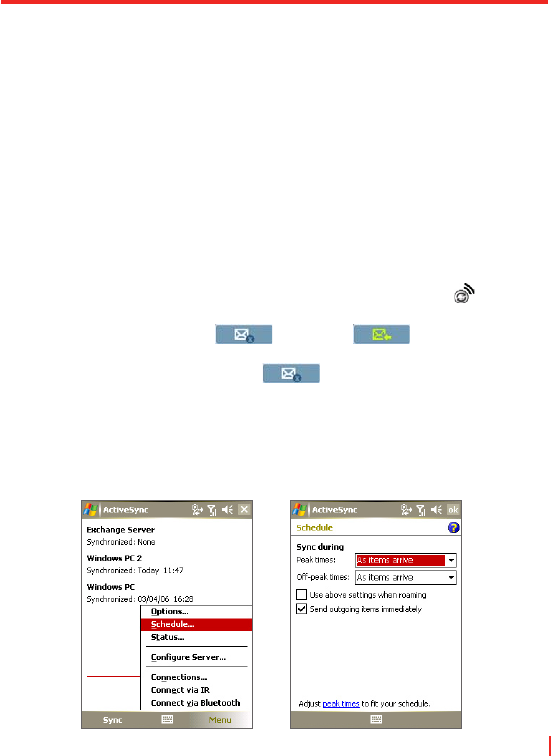
Synchronizing Information and Setting Up E-mail Security | 65
To receive e-mails and synchronize other information instantly
The Direct Push technology (Push E-Mail feature) enables you to
receive new e-mails on your device as soon as they arrive in your
Inbox on the Exchange Server. With this feature, items such as
contacts, calendar and tasks are also immediately updated onto your
device when these items have been changed or new entries have been
added on the Exchange Server. To make Direct Push work, you need
to have a GPRS connection on your device.
The Direct Push feature works for your device only if it is connected to
a private network (corporate network) that is using Microsoft Exchange
Server Service Pack 2 (SP2) with Exchange ActiveSync. You need to
perform a full synchronization between your device and the Exchange
Server first before Direct Push can be enabled.
Using Comm Manager
1. On the Today screen, tap the Comm Manager icon ( ).
2. On the Comm Manager screen, tap the Microsoft Direct Push
button. The button will turn to , which indicates
that you will receive e-mails as they arrive.
When the button is in the state, you need to manually
retrieve your e-mails.
Using ActiveSync
1. In ActiveSync on your device, tap Menu > Schedule.
2. Select As items arrive in the Peak times and Off-peak times
boxes.

66 | Synchronizing Information and Setting Up E-mail Security
Note When both the GPRS and Wi-Fi connections are turned on at the same
time, the Direct Push feature will always opt for GPRS, for which you
could be charged as per your network operator’s service plan.
To schedule synchronization at regular time intervals
You can set how often to synchronize during Peak times (which
usually refer to your working hours) when e-mail volume is high, as
well as Off-peak times when e-mail volume is low.
1. In ActiveSync on your device, tap Menu > Schedule.
2. Select a shorter time interval in the Peak times box for you to be
able to receive e-mails more frequently.
3. Select a longer interval in the Off-peak times box.
Tip To set the days and hours that make up your peak and off-peak times,
tap Adjust peak times to fit your schedule.
4.3 Synchronizing via Infrared and Bluetooth
You can connect your device to the PC to synchronize using the local
wireless technologies, such as infrared (IR) and Bluetooth. These
technologies have almost similar but slightly different requirements.
To synchronize with a computer via infrared
1. Follow the instructions in ActiveSync Help on the computer for
setting up your computer to receive infrared beams.
2. Line up the infrared (IR) ports of your device and your computer
so that they are unobstructed and within close range.
3. On your device, tap Start > Programs > ActiveSync.
4. Tap Menu > Connect via IR.
To synchronize with a computer via Bluetooth
1. Follow the instructions in ActiveSync Help on the computer for
configuring Bluetooth on your computer to support ActiveSync.
2. On your device, tap Start > Programs > ActiveSync.
3. Tap Menu > Connect via Bluetooth. Make sure the Bluetooth
function of both your device and the computer are turned on, and

Synchronizing Information and Setting Up E-mail Security | 67
they are within close range.
4. If this is the first time you have connected to this computer via
Bluetooth, you must first complete the Bluetooth wizard on
your device and set up a Bluetooth partnership between your
device and the computer. For more information about creating a
Bluetooth partnership, see “Bluetooth partnerships” in Chapter 6.
Notes • To preserve battery power, turn off Bluetooth when not in use.
• To connect and synchronize your device with a computer via
Bluetooth, your computer must have a Bluetooth adapter or dongle.
4.4 Synchronizing Music, Video, and Pictures
If you want to carry your music or other digital media along with you
while you travel, ActiveSync works with Windows Media Player to
synchronize music, video, and pictures with your device.
Other than selecting the Media information type in ActiveSync to
be synchronized, all media synchronization settings must be set in
Windows Media Player. Before media can be synchronized, you must
do the following:
• Install Windows Media Player Version 10 on the PC. (Windows
Media Player 10 works only in Windows XP or later versions).
• Connect your device to the PC with a USB cable. If your device
is currently connected using Bluetooth or infrared, you must end
that connection before media can be synchronized.
• Insert a storage card into your device (32MB or larger is
recommended).
• Set up a sync partnership between the storage card and
Windows Media Player.
Change Media synchronization settings
Once you select the Media information type in ActiveSync to be
synchronized, any of your favorite music, video, and picture files in
Windows Media Player playlists can be synchronized. All you have to
do is set up synchronization in Windows Media Player for those media
files.
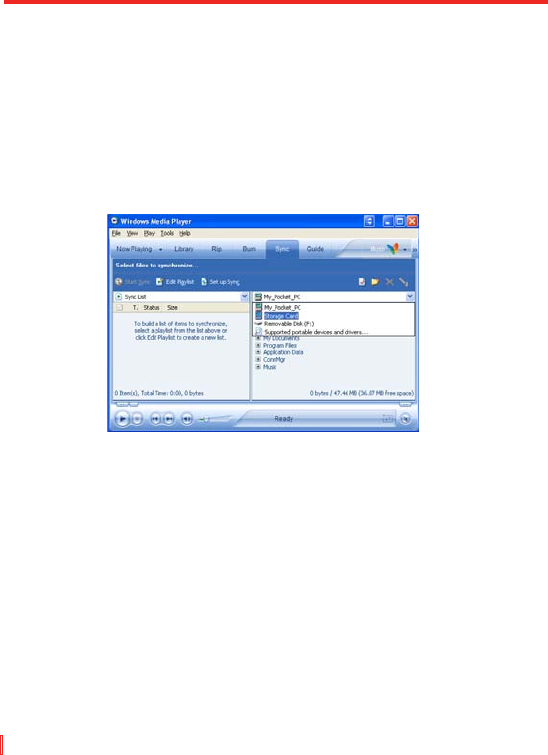
68 | Synchronizing Information and Setting Up E-mail Security
To set up a sync relationship with a storage card
1. On the computer, open Windows Media Player.
2. Click the Sync tab.
3. Select the storage card.
4. Click Set up Sync.
5. Choose whether to synchronize automatically or manually.
For more information about Windows Media Player on your device, see
“Using Windows Media Player” in Chapter 8.
4.5 Setting up E-mail Security
Windows Mobile on your device protects your Outlook e-mails through
Secure/Multipurpose Internet Mail Extension (S/MIME), which allows
you to digitally sign your messages as well as encrypt them.
Using authorization keys and certificates, S/MIME allows you to
digitally sign your e-mail messages to prove your identity to the
recipients. Authorization keys are also used when encrypting
messages to improve privacy and prevent undue tampering or hacking
of your messages. You can encrypt a message with or without a
certificate. However, to read an encrypted message, you need a valid
certificate to decrypt it.
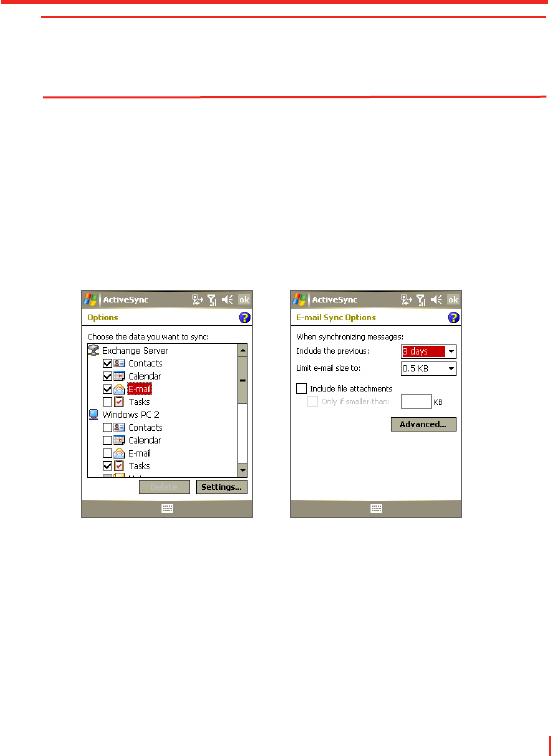
Synchronizing Information and Setting Up E-mail Security | 69
Note S/MIME encryption and digital signatures for Windows Mobile-based
devices are available only with Exchange Server 2003 Service Pack
2 or a later version that supports S/MIME. If you are not using one
of these products, or have not yet synchronized, these options are
unavailable.
Digitally sign and encrypt all messages
ActiveSync allows you to set up S/MIME e-mail encryption and signing.
You must obtain a valid certificate to sign and encrypt e-mail messages
successfully.
1. Tap Start > Programs > ActiveSync.
2. Tap Menu > Options.
3. Select the E-mail information type, and tap Settings. On the E-
mail Sync Options screen, tap Advanced.
4. Do one or both of the following:
• To sign all your outgoing e-mail messages so that recipients
can be certain that the messages were sent by you and have
not been altered in any way, select the Sign all outgoing e-
mail messages check box.
• To encrypt all your outgoing e-mail messages so that the
contents of your messages are protected from being viewed
by anyone other than the intended recipients, select the
Encrypt all outgoing e-mail messages check box.

70 | Synchronizing Information and Setting Up E-mail Security
5. Tap Choose Certificate to select a certificate for signing or
encrypting outgoing e-mail messages.
You can select certificates to sign or encrypt e-mail messages
individually if you do not choose to sign or encrypt all outgoing
e-mail. For information about signing and encrypting individual
messages, see “Individually sign and encrypt a message” in
Chapter 7.

5.1 Personalizing Your Pocket PC Phone
5.2 Adding and Removing Programs
5.3 Managing Memory
5.4 Backing Up Files
5.5 Protecting Your Pocket PC Phone
5.6 Resetting Your Pocket PC Phone
Chapter 5
Managing Your Pocket PC
Phone

72 | Managing Your Pocket PC Phone
5.1 Personalizing Your Pocket PC Phone
Customize the Today screen
The Today screen shows your upcoming appointments, active tasks,
and information about incoming messages. You can customize the
Today screen on your device.
To customize the Today screen
1. Tap Start > Settings > Personal tab > Today.
2. On the Appearance tab, select the desired theme for the
background of the Today screen.
3. On the Items tab, select the items you want to appear on the
Today screen.
Tip To change the order of items displayed on the Today screen, tap the
item, and tap Move Up or Move Down.
To add a custom background image
You can use one of your own pictures as the background image on the
Today screen. Be aware that pictures can affect the readability of text
on the Today screen.
1. Tap Start > Settings > Personal tab > Today.
2. Select the Use this picture as the background check box, and
tap Browse to view a list of your picture files.
3. Tap the file name of the picture you want to use.
4. Tap OK.
To set options for displaying appointments on the Today screen
If you have a large number of appointments, you may want to specify
the kind of appointments that are displayed on the Today screen.
1. Tap Start > Settings > Personal tab > Today.
2. Tap the Items tab.
3. Select Calendar and tap Options.
4. Do any of the following:

Managing Your Pocket PC Phone | 73
• Select Next appointment to show only the next appointment
in your schedule, or Upcoming appointments to show
multiple appointments.
• Clear the Display all day events check box if you do not want
to display all-day events.
To set options for displaying tasks on the Today screen
If you have a large number of tasks, you may want to specify the kind
of tasks that are displayed on the Today screen.
1. Tap Start > Settings > Personal tab > Today.
2. Tap the Items tab.
3. Select Tasks and tap Options.
4. Do any of the following:
• Under Display number of, select the type of tasks you want
to appear on the Today screen.
• In the Category list, select whether to display only tasks
assigned to a specific category or to display all tasks.
Customize the Start menu
You can choose which items appear in the Start menu.
1. Tap Start > Settings > Personal tab > Menus.
2. Select the check boxes of the items you want to appear in the
Start menu. You can select up to seven items.
Tip You can also create folders and shortcuts to appear on the Start menu.
In ActiveSync on your PC, click Explore. In the Mobile Device window,
double-click My Windows Mobile-Based Device > Windows > Start
Menu, then create the folders and shortcuts that you want. You will see
the added items after you synchronize.
Why is the device name important?
The device name is used to identify the device in the following
situations:
• Synchronizing with a PC
• Connecting to a network
• Restoring information from a backup

74 | Managing Your Pocket PC Phone
Note If you synchronize multiple devices with the same PC, each device must
have a unique name.
To change the device name
1. Tap Start > Settings > System tab > About.
2. Tap the Device ID tab.
3. Enter a name.
Note The device name must begin with a letter, consist of letters from A to Z,
numbers from 0 to 9, and cannot contain spaces. Use the underscore
character to separate words.
Set Date / Time / Language / Regional Options
You can set up the correct date, time, language, and regional settings
according to your use.
To set the time and date
1. Tap Start > Settings > System tab > Clock & Alarms > Time
tab.
2. Select the correct time zone and change the date or time.
Note During synchronization, the time on your device is updated with the time
on your PC.
To set an alarm
1. Tap Start > Settings > System tab > Clock & Alarms > Alarms
tab.
2. Tap <Description> and enter a name for the alarm.
3. Tap the day of the week for the alarm. You can select multiple
days by tapping each desired day.
4. Tap the time to open a clock and set the time for the alarm.
5. Tap the alarm icon ( ) to specify the type of alarm you want.
You can choose a flashing light, a single sound, a repeating
sound, or vibration.
6. If you choose to play a sound, tap the list next to the Play sound
check box and tap the sound you want.

Managing Your Pocket PC Phone | 75
To set the time and date for a different location
If you visit or communicate with someone in a particular time zone
often, you can select it as your visiting time zone.
1. Tap Start > Settings > System tab > Clock & Alarms > Time
tab.
2. Tap Visiting.
3. Select the correct time zone and change the time or date.
To change language and regional settings
The style in which numbers, currency, dates, and times are displayed
is specified in regional settings.
1. Tap Start > Settings > System tab > Regional Settings.
2. On the Region tab, select your region and language.
3. The region you select determines which options will be available
on the other tabs.
4. To customize settings further, tap the appropriate tabs and select
the desired options.
Personal and system settings
To reassign programs or shortcuts to program buttons
Your device may come with programs already assigned to hardware
buttons. You can customize these buttons to open the programs you
use most, or to perform certain shortcuts such as changing the screen
orientation, opening the Today screen, or opening Input Panel.
1. Tap Start > Settings > Personal tab > Buttons.
2. A list of buttons and their current assignments are displayed on
the Program Buttons tab.
3. Tap the button you want to reassign. To help you identify the
buttons, there are numbers and icons representing the original
function of the button.
4. In the Assign a program box, tap the program or shortcut you
want to assign.
5. Tap OK.

76 | Managing Your Pocket PC Phone
To increase or decrease the size of text on the screen
1. Tap Start > Settings > System tab > Screen > Text Size tab.
2. Move the slider to increase or decrease the text size.
To choose how to be notified about events or actions
1. Tap Start > Settings > Personal tab > Sounds & Notifications.
2. On the Sounds tab, choose how you want to be notified by
selecting the appropriate check boxes.
3. On the Notifications tab, in Event, tap an event name and
choose how you want to be notified by selecting the appropriate
check boxes. You can choose from several options, such as a
special sound, a message, or a flashing light.
Tip Turning off sounds and the flash light helps conserve battery power.
To adjust the speed for scrolling
Pressing and holding NAVIGATION up or down (Up/Down control)
scrolls through the items in a list. Follow these steps to set the scrolling
speed.
1. Tap Start > Settings > Personal tab > Buttons > Up/Down
Control tab.
2. Do one of the following:
• Under Delay before first repeat, move the slider to shorten
or lengthen the time that elapses before scrolling begins.
• To change the time it takes to scroll from one item to the next,
under Repeat rate, move the slider to adjust the speed.
To find the operating system version number
• Tap Start > Settings > System tab > About.
The version of the operating system on your device is shown near the
top of the About screen.
To get detailed device information
• Tap Start > Settings > System tab > About.

Managing Your Pocket PC Phone | 77
The Version tab displays important device information, including the
type of processor and the amount of memory that is installed.
To make the battery last longer
• Tap on the Today screen. On the Advanced tab of the Power
settings screen, you can specify when your device turns off to
conserve battery power. For optimum conservation, specify 3
minutes or less.
• Use the AC adapter to plug your device into external power
whenever possible, especially when using a Micro SD card or
when using a modem or other peripherals.
• Adjust the backlight settings.
To adjust the brightness of the backlight
1. Tap on the Today screen.
2. On the Power settings screen, tap the Backlight link near the
bottom of the screen.
3. On the Brightness tab, move the slider right to increase the
brightness, or left to decrease the brightness.
To set the backlight to dim after a time delay
1. Tap on the Today screen.
2. On the Power settings screen, tap the Backlight link near the
bottom of the screen.
3. Tap the Battery power tab, or the External power tab.
4. Select the Turn off backlight if device is not used for check
box, and specify the time delay.
Phone settings
You can customize phone settings, such as the ring type and ring tone
to be used for incoming calls, and the keypad tone to be used when
entering phone numbers. Open the Phone program to customize these
settings.

78 | Managing Your Pocket PC Phone
To change the ring tone
1. On the Phone screen, tap Menu > Options > Phone tab.
2. In the Ring tone list, tap the sound you want to use.
Tip To use custom *.wav, *.mid, *.mp3, or *.wma files as ring tones, use
ActiveSync on your PC to copy the files to the /Windows/Rings folder
on your device. Next, select the sound from the Ring tone list. For more
information about copying files to your device, see ActiveSync Help on
your PC.
To change the ring type
You can change the way that you are notified of incoming calls. For
example, you can choose to be notified by a ring, a vibration, or a
combination of both.
1. On the Phone screen, tap Menu > Options > Phone tab.
2. In the Ring type list, tap the desired option.
To change the keypad tone
You can change the tone you hear when entering a phone number on
the keypad. If set to Long tones, the tone is heard continuously for as
long as the number on the keypad is pressed. Use this setting if you
are having trouble accomplishing tasks that rely on tones from your
phone such as accessing messages from an answering machine. If set
to Short tones, the tone is heard only for one or two seconds. If set to
Off, no tone will be heard.
1. On the Phone screen, tap Menu > Options > Phone tab.
2. In the Keypad list, tap the option you want.
Phone services
Phone Services, such as Call Waiting, enable you to choose how to
handle all incoming calls on your device.
To choose the services
1. Tap Start > Settings > Personal tab > Phone > Services tab.
2. Select the service you want to use, then tap Get Settings.

Managing Your Pocket PC Phone | 79
Networks
You can view available mobile phone networks, determine the order
in which your device accesses another network if the current one
is unavailable, and specify whether you want to change networks
manually or automatically. For more information about network
settings, see Help on your device.
To change phone network settings
1. Tap Start > Settings > Personal tab > Phone > Network tab.
2. By default, your device displays the current network as offered
by your service provider. You can customize to set your preferred
network.
To set preferred networks
1. Tap Start > Settings > Personal tab > Phone > Network tab.
By default, the Network selection field is set to Automatic.
However, you can set it to Manual to choose your own network at
any point of time.
2. Tap Set Networks.
3. Select the networks on the Phone: Preferred networks screen
and sort them according to your preference.
4. Tap OK.
5.2 Adding and Removing Programs
Before you purchase additional programs for your device, you should
note the model name of your device, the version of Windows Mobile
software running on it, and the type of processor. This information will
help you select a program that is compatible with your device. For
more information, see “To get detailed device information” and “To find
the operating system version number” in this chapter.
Programs available for purchase usually include a Setup program
(commonly named "setup.exe") that you must first install on your PC.
You can then use ActiveSync to add programs to your device, or add a
program directly from the Internet.

80 | Managing Your Pocket PC Phone
To add programs
1. Download the program to your PC (or insert the CD or disk that
contains the program into your PC). You may see a single *.exe
file, a *.zip file, a Setup.exe file, or several versions of files
for different device types and processors. Be sure to select a
program designed for your device and processor type.
2. Read any installation instructions or documentation that comes
with the program. Many programs provide special installation
instructions.
3. Connect your device to the PC.
4. Double-click the *.exe file.
• If the executable file is an installation wizard, follow the
instructions on the screen. Once the program has been
installed on your PC, the wizard will automatically transfer the
program to your device.
• If an installation wizard does not start, you will see an
error message stating that the program is valid but that it
is designed for a different type of computer. You will need
to copy this program to your device. If you cannot find any
installation instructions for the program, use ActiveSync to
copy the program file to the Program Files folder on your
device.
To remove programs
You can only remove programs that you installed. Programs that come
with your device cannot be removed.
1. Tap Start > Settings > System tab > Remove Programs.
2. In the Programs in storage memory list, select the program you
want to remove, and tap Remove.
3. Tap Yes. If another confirmation message appears, tap Yes
again.

Managing Your Pocket PC Phone | 81
5.3 Managing Memory
You may need to stop a program if it becomes unstable or the program
memory is low.
To see how much memory is available
• Tap Start > Settings > System tab > Memory.
• On the Main tab, the amount of memory allocated to file and
data storage versus program storage is displayed, as well as the
amount of memory in use versus the available memory.
To see available storage card memory
You can see how much memory is available on a storage card that is
inserted in your device.
1. Tap Start > Settings > System tab > Memory.
2. Tap the Storage Card tab.
Tip If you have previously inserted more than one storage card, tap the list
box and then the storage card whose information you want to see.
To free up program memory
Try the following to free memory on your device:
• Close programs you are not currently using.
• Move e-mail attachments to a storage card.
• Move files to a storage card. Tap Start > Programs > File
Explorer. Tap and hold the file, and tap Cut. Browse to the
storage card folder and tap Menu > Edit > Paste.
• Delete unnecessary files. Tap Start > Programs > File Explorer.
Tap and hold the file, and tap Delete.
• Delete large files. To find your largest files, tap Start > Programs
> Search. In the Type list, tap Larger than 64 KB, and tap
Search.
•
In Internet Explorer Mobile, delete temporary Internet files and
clear history information. For more information, see “Internet
Explorer Mobile” in Chapter 6.
• Remove programs you no longer use.
• Reset your device.

82 | Managing Your Pocket PC Phone
To close a program
In most cases, programs automatically close to free needed memory,
however, you can close programs manually, if you prefer.
1. Tap Start > Settings > System tab > Memory > Running
Programs tab.
2. In the Running Programs list, tap the program you want to
close, and tap Stop.
Tip In most programs, you can also use the keyboard shortcut CTRL+Q to
close the program.
5.4 Backing Up Files
You can back up files to your PC using ActiveSync, or copy files to a
storage card you insert into your device. Your device has an expansion
slot for inserting a Micro SD card.
Using ActiveSync, you can copy or move information from the PC
to your device and vice versa. Copying a file results in separate
versions of a file on your device and PC. Because the files are not
synchronized, changes made to one file will not affect the other.
Note If you want to automatically update information on both your device and
PC, synchronize the information instead. For more information about
copying and synchronizing files, see ActiveSync Help on your PC.
To copy files to a storage card
1. Push the storage card into the storage card slot until it clicks into
place. The card is secure when it does not protrude from the
base.
2. Tap Start > Programs > File Explorer and navigate to the
appropriate folder.
3. Tap and hold the file you want to copy, and tap Copy.
4. Tap the folder list (labeled My Documents by default) and tap
Storage Card.
5. Tap Menu > Edit > Paste.

Managing Your Pocket PC Phone | 83
To copy a file between your device and the PC
1. Connect your device to the PC.
2. In ActiveSync, click Explore, which opens the Mobile Device
folder of your device.
3. To copy a file from your device to your PC:
• In the Mobile Device folder, go to the file that you want to
copy.
• Right-click the file, then click Copy.
• Locate the destination folder on your PC. Right-click the
folder, then click Paste.
4. To copy a file from your PC to your device:
• On your PC, navigate to the folder that contains the file you
want to copy.
• Right-click the file, then click Copy.
• Right-click the destination folder under Mobile Device, then
click Paste.
To automatically save files on a storage card
In the Word Mobile, Excel Mobile, and Notes programs, you may find it
helpful to save all new documents, notes, and workbooks directly on a
storage card.
1. From the program file list, tap Menu > Options.
2. With a storage card inserted in your device, in the Save to box,
select the appropriate storage card to automatically save new
items on the storage card.
3. Tap OK.
Note In the file or note list, a storage card symbol is displayed next to the
names of files saved on a storage card.

84 | Managing Your Pocket PC Phone
5.5 Protecting Your Pocket PC Phone
There are two kinds of protection that you can set for your device:
• You can protect your SIM card from unauthorized use by
assigning a PIN (personal identification number). Your first PIN
will be given to you by your wireless service provider; you can
change the PIN later.
• Additionally, you can prevent unauthorized access to any part of
the device by using password protection. You can help keep your
data more secure by requiring a password every time the device
is turned on. You create your own password when you begin
using your device.
To protect your SIM card with a PIN
1. On the Phone screen, tap Menu > Options > Phone tab.
2. Tap Require PIN when phone is used.
3. To change the PIN at any time, tap Change PIN.
Tip Emergency calls can be placed at any time, without requiring a PIN.
To protect your device with a password
1. Tap Start > Settings > Personal tab > Lock.
2. Select the Prompt if device unused for check box, and in the
box to the right, select how long your device must be turned off
before a password is required. In the Password type box, select
the type of password you would like to use. Enter the password
and, if necessary, confirm the password.
If your device is configured to connect to a network, use an
alphanumeric password for increased security for your device.
3. On the Hint tab, enter a phrase that will help you remember your
password, but does not allow others to guess your password.
The hint will be displayed after the wrong password is entered
four times.
4. Tap OK. The next time the device is turned on, you will be
prompted to enter your password.

Managing Your Pocket PC Phone | 85
Notes •
Each time a wrong password is entered, the device response time
gets longer until the device appears to be not responding.
• If you forget your password, you must follow the instructions in this
user manual to clear the memory before you can access your device.
To change your password
1. Tap Start > Settings > Personal tab > Lock. You will be
prompted to enter your current password.
2. In the Password box, enter your new password.
3. On the Hint tab, enter a phrase that will help you remember
your new password, but does not allow others to guess your
password.
The hint will be displayed after the wrong password is entered
four times.
4. Tap OK.
To display owner information on the ‘my info’ screen
Having your contact information displayed on the ‘my info’ screen on
startup allows for easy identification of the device in case it is lost.
1. Tap Start > Settings > Personal tab > Owner Information.
2. On the Options tab, select the Identification information check
box.
3. If you want additional text displayed, tap the Notes tab and enter
the text (for instance: Reward if found).
4. On the Options tab, select the Notes check box.
5. Tap OK.
Tip To display owner information on the Today screen, tap Start > Settings
> Personal tab > Today. On the Items tab, select the Owner Info
check box.
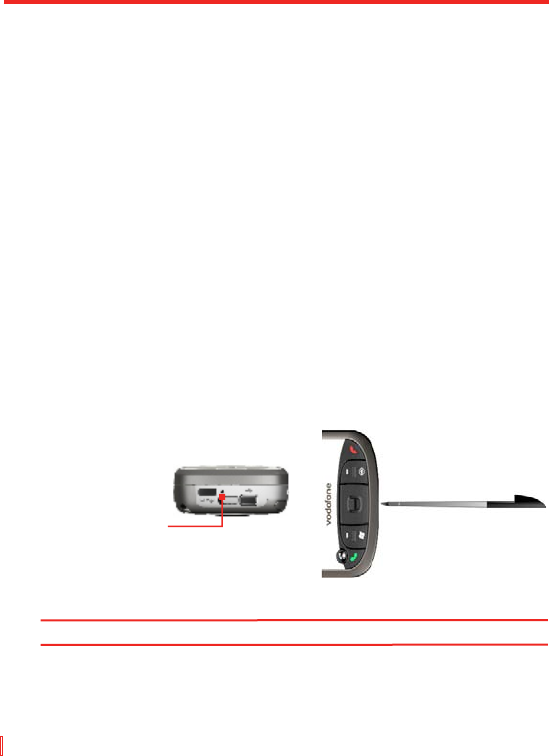
86 | Managing Your Pocket PC Phone
5.6 Resetting Your Pocket PC Phone
Occasionally, you may need to reset your device. A normal (or soft)
reset of your device clears all active program memory and shuts down
all active programs. This can be useful when your device is running
slower than normal, or a program is not performing properly. A soft
reset is also necessary after the installation of some programs. If a soft
reset is performed when programs are running, unsaved work will be
lost.
You can also perform a hard reset (also known as a full reset). A hard
reset should be performed only if a normal reset does not solve a
system problem. After a hard reset, the device is restored to its default
settings — the way it was when you first purchased it and turned it
on. Any programs you installed, data you entered, and settings you
customized on your device will be lost. Only Windows Mobile software
and other pre-installed programs will remain.
To perform a soft reset
• Use the stylus to lightly press and hold the RESET button on
the bottom of your device. Your device restarts and displays the
Today screen.
RESET button
Warning! Always turn off your device before performing a soft reset.
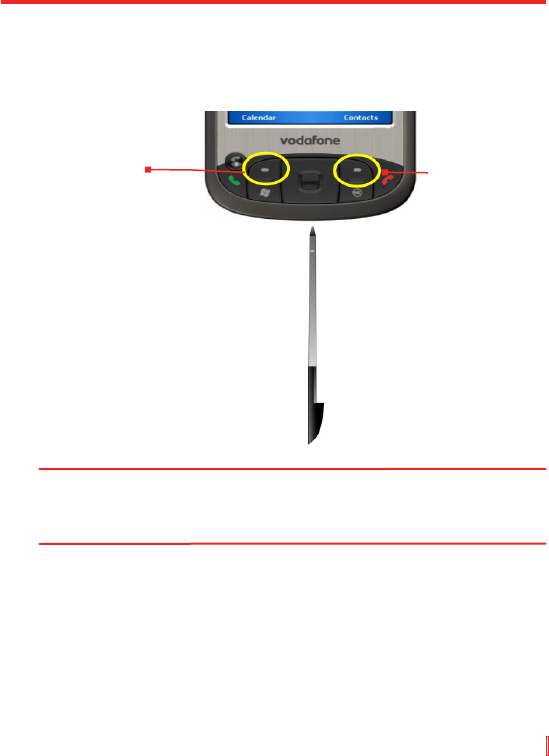
Managing Your Pocket PC Phone | 87
To perform a hard reset
Press and hold the Left SOFT KEY and the Right SOFT KEY, and at
the same time, use the stylus to press the RESET button at the bottom
of your device.
Left SOFT KEY Right SOFT KEY
Warning! Always turn off your device before performing a hard reset. Your
device will be set back to factory default settings. Please ensure any
additional installed programs and/or user data have been backed up
before a hard reset is performed.

88 | Managing Your Pocket PC Phone

6.1 Connecting to the Internet
6.2 Internet Explorer
6.3 Using Comm Manager
6.4 Using Bluetooth
6.5 Using Wi-Fi
6.6 Using Wireless Modem
6.7 Using Terminal Services Client
Chapter 6
Getting Connected

90 | Getting Connected
6.1 Connecting to the Internet
Your device is equipped with powerful networking functions that enable
you to connect to the Internet through Wi-Fi, GPRS (General Packet
Radio Service) or the mobile phone network
Connecting your device to the Internet through a private or free
wireless network is your best choice since this will not incur any cost.
Take note, however, that using Wi-Fi on your device will drain battery
power faster. For more information about setting up a Wi-Fi connection,
see “Using Wi-Fi” later in this chapter.
In times when you are not within the coverage of a wireless network,
you can either use GPRS or phone dial-up to connect your device to
the Internet or your corporate network. Your device has two groups of
connection settings: ISP (Internet Service Provider) and WAP. The ISP
settings are used to connect to the Internet, while WAP settings can be
used to connect to any private, corporate network.
To set up a GPRS connection to the Internet
GPRS is a non-voice value-added service that allows information to
be sent and received across a mobile telephone network. You can use
GPRS to connect to the Internet or to send and receive MMS on your
device. You will be billed per KB (Kilobyte) by your wireless service
provider when you are sending or receiving information via GPRS.
If GPRS settings are not preset on your device, obtain the Access
point name from your wireless service provider. Also, check with your
wireless service provider if a user name and password are required.
1. Tap Start > Settings > Connections tab > Connections.
2. In ISP, tap Add a new modem connection.
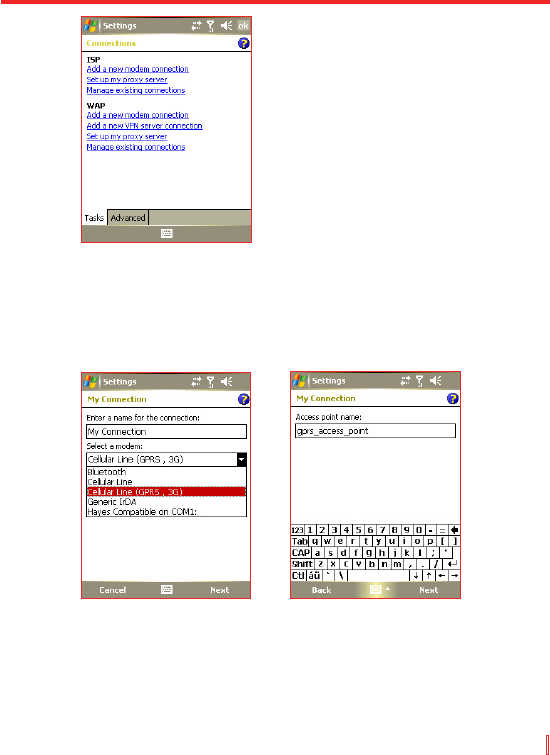
Getting Connected | 91
3. On the Make New Connection screen, enter a name for the
connection.
4. In the Select a modem list, select Cellular Line (GPRS, 3G),
then tap Next.
5. Enter the Access point name, then tap Next.
6. Enter the user name and password, only if required.
7. Tap Finish.

92 | Getting Connected
Notes •
To view help information for any screen, tap the help icon ( ).
•
To modify your connection settings, tap Manage existing
connections on the Connections screen, and complete the
connection wizard.
To set up a dial-up connection to your ISP
When you use your device to dial up to your ISP and connect to the
Internet, you will be billed by the number of minutes that you use.
To establish a dial-up connection on your device, you need the same
settings that you normally use when you dial up from your computer.
This includes the ISP server phone number, your user name and
password.
1. Tap Start > Settings > Connections tab > Connections.
2. In ISP, tap Add a new modem connection.
3. On the Make New Connection screen, enter a name for the
connection.
4. In the Select a modem list, select Cellular Line, then tap Next.
5. Enter the ISP server phone number, then tap Next.
6. Enter your user name, password, and any other information
required by your ISP.
7. Tap Finish.
To connect to a private network
1. Obtain the following information from your network administrator:
• Server phone number
• User name
• Password
• Domain (and other required settings, such as IP address)
2. Tap Start > Settings > Connections tab > Connections.
3. In WAP, follow the instructions for each type of connection.
4. Complete the connection wizard, then tap Finish.

Getting Connected | 93
Note To start browsing the Internet or private network, tap Start > Programs
> Internet Explorer.
To set up a network card
You can insert and use a network card on your device to connect
directly to a local area network (LAN) at your home or workplace. Once
connected, you can view the Internet or intranet, or download e-mail on
your device. Ensure you purchase and configure a network card that is
compatible with your device.
1. Insert the network card into your device.
2. The first time you insert the card, Network Settings will appear
automatically so that you can configure the network card. If it
does not appear, or to change settings later, tap Start > Settings
> Connections tab > Network Cards.
3. To enter specific server information, tap the appropriate network
adapter in the Tap an adapter to modify settings list, and
then tap Name Servers. Most networks use DHCP dynamic IP
addressing, so you should not have to change these settings
unless you have been instructed to do so.
4. If necessary, connect the network card to the network by using a
network cable. For information, see the documentation that came
with your network card.
5. To start a connection, insert the network card, and begin using a
desired program, such as Internet Explorer Mobile, to browse the
Internet. Your device will connect automatically.
Note If you use your network card with two networks, such as a private
network at work and one at home for the Internet, you will need to
change the network to which the network card connects. Tap Start >
Settings > Connections tab > Network Cards, then in the My network
card connects to list, select The Internet or Work, depending on
which network to connect the network card.

94 | Getting Connected
6.2 Internet Explorer
Internet Explorer is a full-featured Internet browser, optimized for use
on your device.
To start Internet Explorer
•
Tap Start > Internet Explorer or press the INTERNET EXPLORER
button on your device
.
To set a Home page
1. In the address bar on top of the Internet Explorer screen, enter
the desired Web page address. Tap to open the Web page.
2. Tap Menu > Tools > Options > General tab.
3. Do one of the following:
• To use the displayed page as the Home page, tap Use
Current.
• To use the default Home page, tap Use Default.
Tip To go to your Home page, tap Menu > Home.
To transfer favorites from your PC
You can transfer the favorites you have stored on your PC to your
device by synchronizing the Internet Explorer favorites on your PC with
your device.
1. In ActiveSync on your PC, on the Tools menu, click Options, and
select Favorites.
2. In Internet Explorer on your PC, click Favorites > Add to
Favorites and save or move favorite links to the Mobile Favorites
subfolder in the Favorites list.
3. Connect your device to your PC. If synchronization does not start
automatically, click Sync.
To add a favorite
1. In Internet Explorer Mobile, go to the page you want to add.
2. Tap and hold the page, and tap Add to Favorites.
3. Confirm or change the name, and select a folder for storing the
favorite.

Getting Connected | 95
To delete a favorite or folder
1. In Internet Explorer Mobile, tap Menu > Favorites > Add/Delete
tab.
2. Select the item you want to delete, and tap Delete.
To change the size of text on Web pages
• In Internet Explorer Mobile, tap Menu > Zoom, and tap the size
you want.
To change how Web pages fill the screen
1. In Internet Explorer Mobile, tap Menu > View.
2. Tap one of the following:
• One Column. Arranges the content into one column that is
as wide as the screen. This means that you will rarely have to
scroll horizontally.
• Default. Maintains a layout similar to what you see on a
desktop computer, but it makes items smaller and arranges
the content so that you can see most of it without having to
scroll horizontally.
• Desktop. Keeps the same layout and size as on a desktop
computer, which will require both horizontal and vertical
scrolling.
To clear the History list
1. In Internet Explorer Mobile, tap Menu > Tools > Options >
Memory tab.
2. Tap Clear History.
To save a picture from a Web page
1. In Internet Explorer Mobile, tap and hold the picture, and tap
Save Image.
2. Do one of the following:
• To save the picture in My Pictures on your device, tap Yes.
• To save the picture in another location, such as a storage
card, tap Save As.

96 | Getting Connected
To delete temporary Internet files
Your device temporarily stores Web pages that you frequently visit or
have visited recently to speed up the display of these Web pages when
you access them. You may want to delete these files to free storage
space.
1. In Internet Explorer Mobile, tap Menu > Tools > Options >
Memory tab.
2. Tap Delete Files. All pages stored on your device, including
offline favorites content, will be deleted.
To set up Internet security settings
Cookies are small files containing information about your identity and
preferences so that a page can tailor information to your needs. The
page sends the file, and it is stored on your device.
1. In Internet Explorer Mobile, tap Menu > Tools > Options >
Security tab.
2. To prevent Internet Explorer Mobile from accepting any cookies,
clear the Allow cookies check box.
3. Select the check boxes for the other security options you want,
and tap OK.
6.3 Using Comm Manager
Comm Manager acts like a central switcher that lets you enable or
disable phone features as well as manage your data connections
easily.
To open Comm Manager
• Tap the Comm Manager icon ( ) on the Today screen.
• Tap the COMM MANAGER button on your device.
Simply tap the corresponding button to enable or disable a feature.
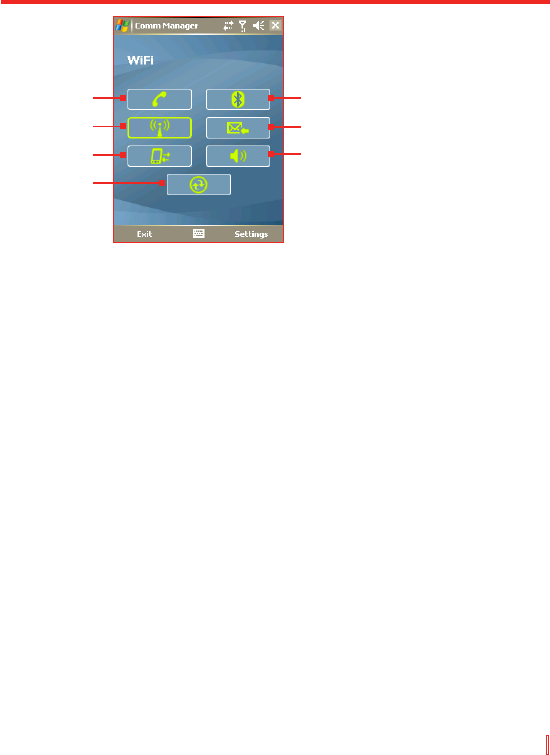
Getting Connected | 97
1Tap to toggle between enabling or disabling the phone.
2Tap to toggle between turning on or off Wi-Fi. Tap Settings > Wi-Fi
Settings to configure Wi-Fi on your device. See "Using Wi-Fi" for details.
3Tap to disconnect active data services (e.g. GPRS). You cannot reconnect
data services in Comm Manager.
4Tap to open ActiveSync so you can synchronize the device and computer.
For more information about the configuration settings for ActiveSync, see
Chapter 4.
5Tap to toggle between turning on or off Bluetooth. Tap Settings >
Bluetooth Settings to configure Bluetooth on your device. See "Using
Bluetooth" for details.
6Tap to toggle between automatically receiving (as items arrive) or
manually retrieving Outlook e-mails. For more information, see "Schedule
synchronization with Exchange Server" in Chapter 4.
7Tap to toggle between turning on the phone's ringer or setting the phone to
vibration/mute mode.
1
2
3
5
6
7
4
Comm Manager screen

98 | Getting Connected
6.4 Using Bluetooth
Bluetooth is a short-range wireless communications technology.
Devices with Bluetooth capabilities can exchange information over a
distance of about 10 meters without requiring a physical connection.
You can even beam information to a device in a different room, as long
as it is within the Bluetooth signal coverage range.
Bluetooth can be used in the following ways:
• Beam information, such as files, appointments, tasks, and contact
cards, between devices that have Bluetooth capabilities.
• Synchronize information between your device and computer via
Bluetooth.
• Use a Bluetooth-enabled headset (or other Bluetooth-enabled
hands-free device such as a car kit) with your device for hands-
free phone conversations.
• Use a Bluetooth service. Once you connect to another device
or computer using Bluetooth, you can locate and use any of the
services available on that device.
• Create a connection between your device and another Bluetooth-
enabled phone to use that phone as a modem.
Note Normally, you will need another phone as a modem only if your Pocket
PC device has no integrated phone capability.
Bluetooth modes
Bluetooth on your device operates in three different modes:
• On. Bluetooth is turned on. Your device can detect other
Bluetooth-enabled devices, but not vice versa.
• Off. Bluetooth is turned off. In this mode, you can neither send
nor receive information using Bluetooth. You might want to turn
the radio off at times in order to conserve battery power, or in
situations where radio use is prohibited, such as on board an
aircraft and in hospitals.
• Discoverable. Bluetooth is turned on, and all other Bluetooth-
enabled devices within a range of 10 meters can detect your
device.

Getting Connected | 99
Note By default, Bluetooth is turned off. If you turn it on, then turn off your
device, Bluetooth also turns off. When you turn on your device again,
Bluetooth automatically turns on.
To turn Bluetooth on and make your device discoverable
1. On your device, tap Start > Settings > Connections tab >
Bluetooth.
2. Select the Turn on Bluetooth and Make this device
discoverable to other devices check boxes.
3. Tap OK.
Bluetooth partnerships
A Bluetooth partnership is a relationship that you create between your
device and another Bluetooth-enabled device in order to exchange
information in a secure manner. Creating a partnership between two
devices involves entering the same passkey on both devices.
Creating a partnership between two devices is a one-time process.
Once a partnership is created, the devices can recognize the
partnership and exchange information without entering a passkey
again. Make sure the two devices are within a range of 10 meters from
one another, and Bluetooth is turned on and in discoverable mode.
To create a Bluetooth partnership
1. On your device, tap Start > Settings > Connections tab >
Bluetooth.
2. On the Devices tab, tap New Partnership. Your device
searches for other Bluetooth devices and displays them in the
box.
3. Tap the desired device name in the box.
4. Tap Next.
5. Specify a passkey to establish a secure connection. The
passkey can be 1 up to 16 characters.
6. Tap Next.
7. Wait for the paired device to accept the partnership. The
receiving party needs to enter the same passkey that you
specified.

100 | Getting Connected
8. The name of the paired device is then displayed. You may edit
and enter a new name for that device.
9. Select the check boxes of services that you want to use from the
paired device.
10. Tap Finish.
To accept a Bluetooth partnership
1. Ensure that Bluetooth is turned on and in discoverable mode.
2. Tap Yes when prompted to establish a partnership with the other
device.
3. Enter a passkey (the same passkey that is entered on the device
requesting the partnership) to establish a secure connection. The
passkey must be between 1 and 16 characters.
4. Tap Next.
5. Tap Finish. You can now exchange information with the paired
device.
To rename a Bluetooth partnership
1. Tap Start > Settings > Connections tab > Bluetooth.
2. Tap and hold the partnership on the Devices tab.
3. On the shortcut menu, tap Edit.
4. Enter a new name for the partnership.
5. Tap Save.
To delete a Bluetooth partnership
1. Tap Start > Settings > Connections tab > Bluetooth.
2. Tap and hold the partnership on the Devices tab.
3. Tap Delete.
Connect a Bluetooth hands-free headset
For hands-free phone conversations, you can use a Bluetooth hands-
free headset such as a car kit with your device.
Just like when connecting to any Bluetooth device, you also need to
enter a passkey when connecting to a Bluetooth hands-free headset.